FGV
Exibindo questões de 701 a 800.
A partir das tabelas e da história brasileira desde os anos - FGV 2016
História - 2016Leia as tabelas.
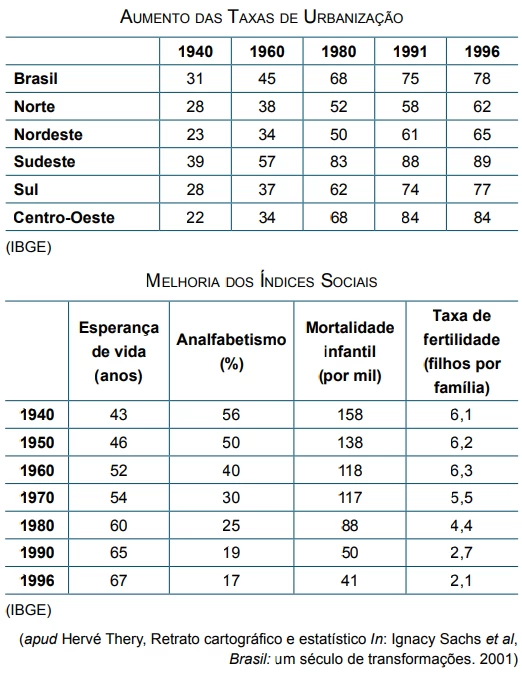
Das sete maravilhas mencionadas pelo grego Antíparo de - FGV 2016
Geografia - 2016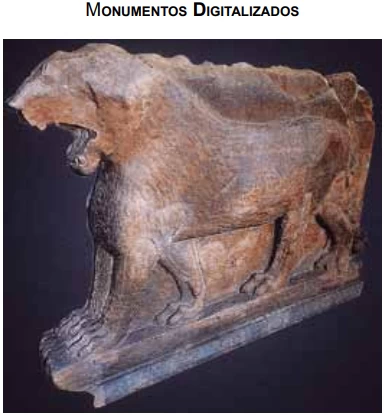
Das sete maravilhas mencionadas pelo grego Antíparo de Sídon há mais de 2100 anos, hoje só se pode conferir uma, a pirâmide egípcia de Quéops. Para que a humanidade não sofra no futuro com o mesmo lapso, arqueólogos e especialistas em impressão 3D criaram o Projeto Mosul. O objetivo é recriar no computador relíquias que estão sendo destruídas pelos terroristas do Estado Islâmico, como um leão do museu de Mosul.
Os mapas a seguir mostram, em destaque, a evolução do - FGV 2016
Geografia - 2016Os mapas a seguir mostram, em destaque, a evolução do Império Otomano, que, ao se desfazer na década de 1910, permitiu o surgimento de algumas nações, enquanto outros territórios que lhe pertenciam passaram para o controle colonial de algumas nações imperialistas europeias. Alguns povos tentaram a independência e foram massacrados pelo exército turco. Em um desses massacres, morreram aproximadamente 1,5 milhão de pessoas.
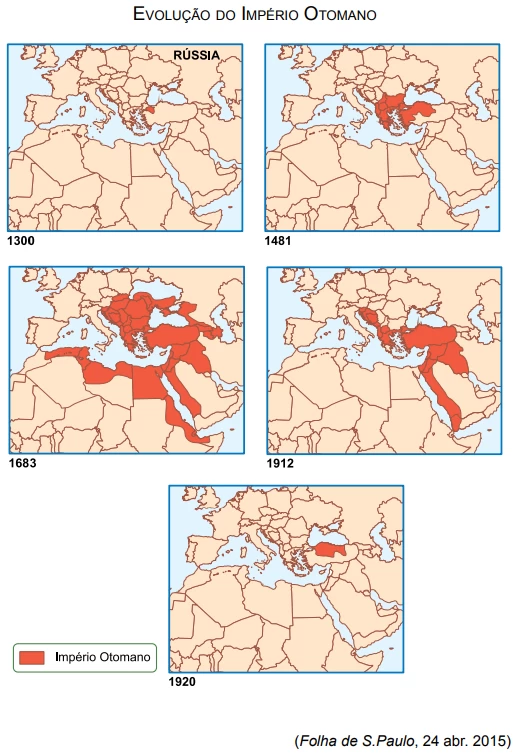
Paris será a sede, no final de novembro de 2015, da COP-21 - FGV 2016
Geografia - 2016Paris será a sede, no final de novembro de 2015, da COP-21 (Conferência das Partes), em que se buscará a criação do novo acordo climático global para substituir o Protocolo de Kyoto e limitar o aumento na temperatura em 2 °C até 2100.
Em novembro de 2014, Estados Unidos e China haviam fechado acordo para redução das emissões, com metas variáveis entre 2025 e 2050. Os países emergentes, no entanto, cobraram metas mais ambiciosas e claras.
Todos os esforços feitos até agora para criar esboço do novo acordo climático têm esbarrado na divisão de dois blocos: países desenvolvidos e em desenvolvimento. Ambos ainda estão preocupados com as responsabilidades que caberão a cada grupo nas ações para reduzir as emissões de gases do efeito estufa.
É grande a preocupação com o bloco tanto pelo imobilismo de - FGV 2016
Geografia - 2016É grande a preocupação com o bloco tanto pelo imobilismo de suas regras quanto pelo isolamento em relação aos acordos comerciais. A paralisia do grupo regional e as crescentes medidas protecionistas da Argentina preocupam o setor privado brasileiro, o maior prejudicado por essa situação.
É previsível a continuada oposição da Argentina e da Venezuela à flexibilização das regras do bloco. É do interesse brasileiro ignorar essa oposição e assumir a liderança nas tratativas para retomar os entendimentos com a UE e aceitar a ampliação na negociação externa com países mais desenvolvidos, como o Canadá e a Coreia do Sul. A Espanha defendeu abertamente uma opção pragmática para que as conversações entre a União Europeia e o bloco possam avançar
Os anos de bonança para os países produtores e exportadores - FGV 2016
Geografia - 2016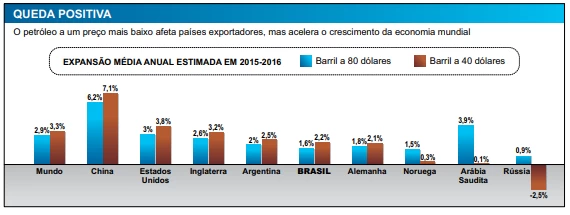
Considerado uma fonte estratégica para todo o mundo e, - FGV 2016
Geografia - 2016
Considerado uma fonte estratégica para todo o mundo e, principalmente, para o Brasil, o mar vem chamando a atenção de especialistas em energia, que já testam e implantam algumas alternativas de geração, como a usina de ondas. Localizada no quebra-mar do Porto de Pecém, a usina de ondas é a primeira na América Latina responsável pela geração de energia elétrica por meio do movimento das ondas do mar. Com tecnologia 100% nacional, a estimativa é de que o equipamento de baixo impacto ambiental esteja completamente pronto para funcionar até o ano de 2020.
Leia o texto a seguir. O país exportou menos armas em 2014 - FGV 2016
Geografia - 2016Leia o texto a seguir. O país exportou menos armas em 2014. Cortes nos orçamentos de defesa de vários países ocidentais fizeram sistemas bélicos do país cair para US$ 5,7 bilhões – US$ 1 bilhão a menos do que em 2013. Inesperadamente, outro segmento relacionado à segurança ocupou o espaço vazio. Pela primeira vez, vendeu mais softwares de cibersegurança do que armas. Segundo dados divulgados recentemente pela força- -tarefa em cibernética, em 2014, suas empresas faturaram cerca de US$ 6 bilhões com softwares destinados a prover segurança na internet, valor que corresponde a aproximadamente 10% do faturamento mundial do segmento.
Além disso, o país também está produzindo grande quantidade de startups de cibersegurança. Em 2014, oito delas foram vendidas para investidores estrangeiros por um total de US$ 700 milhões.
Nele o número de companhias de cibersegurança dobrou ao longo dos últimos cinco anos. Hoje são 300. A demanda por seus produtos aumentou muito, agora que governos e empresas se deram conta de que precisam se proteger contra os hackers. Esse país dispõe de um contingente considerável de engenheiros de software experientes, oriundos, em sua maioria, de dois importantes mananciais: em primeiro lugar, os quadros de funcionários dos 280 centros de alta tecnologia mantidos no país por multinacionais estrangeiras, de onde saem indivíduos que começam a se lançar em empreendimentos próprios; e, em segundo lugar, as fileiras das forças armadas do país, das quais, todos os anos, são dispensadas centenas de pessoas tecnologicamente capacitadas. Há décadas, os militares vêm desenvolvendo seu arsenal – tanto defensivo quanto ofensivo – para o conflito cibernético, e essa política agora está pagando dividendos.
As fotos a seguir mostram cinco diferentes tipos de formaçõ - FGV 2016
Geografia - 2016As fotos a seguir mostram cinco diferentes tipos de formações vegetais presentes nos ambientes brasileiros.

Analise o seguinte pluviograma:

Um dos mais sérios problemas com o qual a Europa se - FGV 2016
Geografia - 2016Um dos mais sérios problemas com o qual a Europa se defronta hoje em dia é a questão migratória. Não que isso seja novidade: ao longo de todo o século XX, a Europa sempre se viu às voltas com grupos que saíam do continente, ou para ele se dirigiam. Porém, atualmente, a migração se tornou uma questão traumática. O mapa a seguir, intitulado “Rotas de Fuga”, mostra os caminhos que os migrantes adotam.

As variações de temperatura ao longo dos dias e noites nas - FGV 2016
Geografia - 2016As variações de temperatura ao longo dos dias e noites nas diferentes estações do ano causam expansão e contração térmica nos materiais rochosos, levando à fragmentação dos grãos minerais. Além disso, os minerais, com diferentes coeficientes de dilatação térmica, comportam-se de forma diferenciada às variações de temperatura, o que provoca deslocamento relativo entre os cristais, rompendo a coesão inicial entre os grãos.
As variações de temperatura ao longo dos dias e noites nas - FGV 2016
Geografia - 2016As variações de temperatura ao longo dos dias e noites nas diferentes estações do ano causam expansão e contração térmica nos materiais rochosos, levando à fragmentação dos grãos minerais. Além disso, os minerais, com diferentes coeficientes de dilatação térmica, comportam-se de forma diferenciada às variações de temperatura, o que provoca deslocamento relativo entre os cristais, rompendo a coesão inicial entre os grãos.
A ANP, Agência Nacional de Petróleo, responsável pela admin - FGV 2016
Geografia - 2016A ANP, Agência Nacional de Petróleo, responsável pela administração das reservas brasileiras de petróleo e gás em regime de monopólio estatal, informa que as jazidas brasileiras estão assim distribuídas:
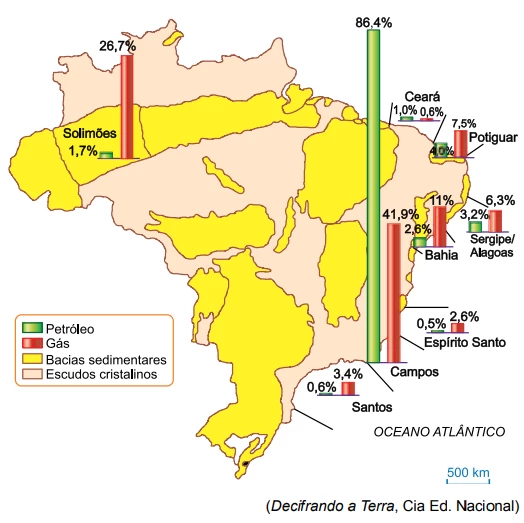
Observe a caricatura a seguir do líder sírio Bashar al - FGV 2016
Geografia - 2016Observe a caricatura a seguir do líder sírio Bashar al-Assad.
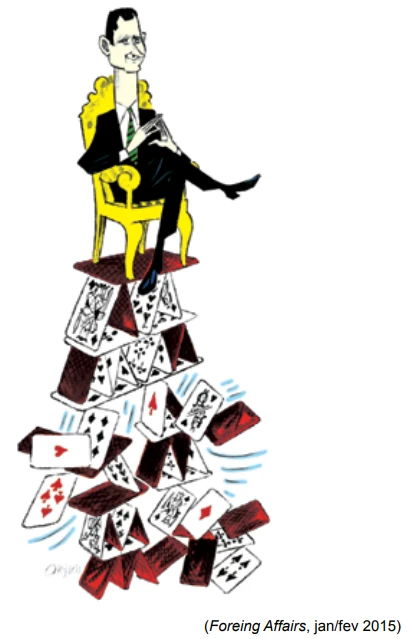
A questão climática vem preocupando a comunidade mundial - FGV 2016
Geografia - 2016A questão climática vem preocupando a comunidade mundial nos últimos anos. Criou-se, inclusive, o termo “pegada ecológica”, o rastro deixado por uma comunidade em função de seu índice de consumo, daí derivando os termos “pegada hídrica” e “pegada de carbono”, como se observa no gráfico a seguir.
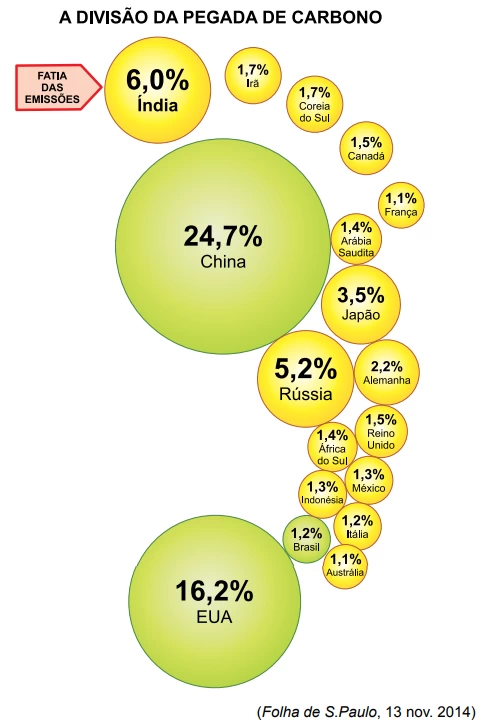
O país passa por uma grave crise econômica caracterizada - FGV 2016
Geografia - 2016O país passa por uma grave crise econômica caracterizada por uma inflação galopante, câmbio descontrolado e sérios problemas de desabastecimento de bens e produtos básicos.
As filas passaram a fazer parte do cotidiano do país. Falta de leite a farinha de milho – base da receita da arepa, um dos principais alimentos da dieta desse país –, de fralda descartável a pasta de dente, de material escolar a medicamentos.
Há, certamente, mais de uma razão para explicar o índice de desabastecimento, que atinge 75% dos produtos monitorados pelo governo, e é quase certo também que ele exercerá uma influência decisiva nas próximas eleições parlamentares.
Há controle oficial de preços, ameaça a setores produtivos, falta de incentivo à indústria, desconfiança do mercado, ausência de crédito e uma série de questões que afetam as produções de bens e produtos. Nenhum grande país produtor de petróleo sentiu o impacto da fortíssima queda das cotações tanto quanto esse país, onde o petróleo responde por 96% das exportações.
Em fins de abril de 2015, o vulcão Calbuco, localizado no - FGV 2016
Geografia - 2016Em fins de abril de 2015, o vulcão Calbuco, localizado no Chile, 1000 km ao sul de Santiago, produziu uma gigantesca quantidade de cinzas que atingiu Buenos Aires (provocando o fechamento dos aeroportos da cidade), Montevidéu e até mesmo Porto Alegre, no Rio Grande do Sul.
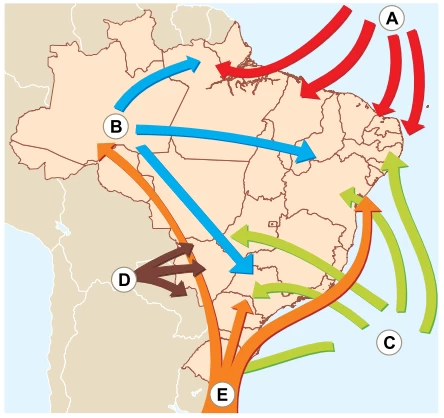
According to the block comprising the first four paragraphs - FGV 2016
Inglês - 2016Read the text and answer the question
A Housing Meltdown Looms in Brazil as Builders Seek Debt Relief
by Julia Leite and Paula Sambo
August 26, 2015
Not long ago, Brazil’s real-estate market was one of the biggest symbols of the country’s burgeoning economic might. Now, it’s fallen victim to an ever-deepening recession. PDG Realty SA, once the largest homebuilder by revenue, hired Rothschild last week to help restructure 5.8 billion reais ($1.6 billion) of debt after second-quarter net sales sank 88 percent. Earlier this month, Rossi Residencial SA, which has 2.5 billion reais in debt, also brought in advisers to “restructure operations and review strategies.” Since 2010, the builder has lost 99 percent of its stock-market value.
The real-estate industry, which is equal to about 10 percent of Brazil’s economy, is emerging as one of the latest casualties of a recession that analysts forecast will be its longest since the 1930s. To make matters worse, interest rates are the highest in almost a decade while inflation is soaring. “There is no real estate company that survives without sales,” Bruno Mendonça Lima de Carvalho, the head of fixed income at Guide Investimentos SA, said from Sao Paulo. “You can’t import or export apartments. You’re relying solely on domestic activity.”
PDG tried to boost revenue by lowering prices, financing up to 20 percent of some home purchases and even offering to buy back apartments if banks deny financing. Still, it sold just 217 units in the second quarter on a net basis, compared with 1,749 in 2014.
Negative Outlook
On Friday, Moody’s Investors Service cut PDG’s rating three levels to Caa3, citing the possibility of significant losses for bondholders and other lenders. Secured creditors may recover less than 80 percent in a default, according to Moody’s, which kept a negative outlook on the rating. “The company is facing additional liquidity pressures from a prolonged deterioration in industry dynamics, including weak sales speed, tight financing availability and declining real estate prices,” Moody’s said.
Sao Paulo-based Rossi said in an e-mailed response to questions that second quarter sales improved and that the company’s main focus is to reduce debt. Gross debt fell about 30 percent in the 12 months ended in June, Rossi said.
Home sales in Latin America’s biggest economy tumbled 14 percent in the first half of 2015, according to data from the national real estate institute. Builders cut new projects by 20 percent during that span, while available financing shrank by about a quarter
Real’s Collapse
That’s a reversal from just two years ago, when realestate prices in places like Rio de Janeiro and Sao Paulo had surged as much as 230 percent as rising incomes, a soaring real and record-low borrowing costs ignited a wave of home buying.
Brazilians find themselves in drastically different circumstances today. The currency fell 0.4 percent Wednesday as of 3:25 p.m. in New York, extending its loss this year to 26 percent. The jobless rate climbed to a five-year high of 7.5 percent last month.
The central bank boosted its key rate to 14.25 percent in July, making it ever more expensive to finance the purchase of a home. “It’s a matter of demand, and demand is really weak,” Will Landers, who manages Latin American stocks at BlackRock, said from Princeton, New Jersey. “We may have reached a peak in interest rates, but they should continue to be at these levels for a while. Consumers will stay on the sidelines because debt levels are still high, and employment will get worse.”
(Business Week at www.bloomberg.com/news. Adapted)
The third paragraph implies that (A) with the high interest - FGV 2016
Inglês - 2016Read the text and answer the question
A Housing Meltdown Looms in Brazil as Builders Seek Debt Relief
by Julia Leite and Paula Sambo
August 26, 2015
Not long ago, Brazil’s real-estate market was one of the biggest symbols of the country’s burgeoning economic might. Now, it’s fallen victim to an ever-deepening recession. PDG Realty SA, once the largest homebuilder by revenue, hired Rothschild last week to help restructure 5.8 billion reais ($1.6 billion) of debt after second-quarter net sales sank 88 percent. Earlier this month, Rossi Residencial SA, which has 2.5 billion reais in debt, also brought in advisers to “restructure operations and review strategies.” Since 2010, the builder has lost 99 percent of its stock-market value.
The real-estate industry, which is equal to about 10 percent of Brazil’s economy, is emerging as one of the latest casualties of a recession that analysts forecast will be its longest since the 1930s. To make matters worse, interest rates are the highest in almost a decade while inflation is soaring. “There is no real estate company that survives without sales,” Bruno Mendonça Lima de Carvalho, the head of fixed income at Guide Investimentos SA, said from Sao Paulo. “You can’t import or export apartments. You’re relying solely on domestic activity.”
PDG tried to boost revenue by lowering prices, financing up to 20 percent of some home purchases and even offering to buy back apartments if banks deny financing. Still, it sold just 217 units in the second quarter on a net basis, compared with 1,749 in 2014.
Negative Outlook
On Friday, Moody’s Investors Service cut PDG’s rating three levels to Caa3, citing the possibility of significant losses for bondholders and other lenders. Secured creditors may recover less than 80 percent in a default, according to Moody’s, which kept a negative outlook on the rating. “The company is facing additional liquidity pressures from a prolonged deterioration in industry dynamics, including weak sales speed, tight financing availability and declining real estate prices,” Moody’s said.
Sao Paulo-based Rossi said in an e-mailed response to questions that second quarter sales improved and that the company’s main focus is to reduce debt. Gross debt fell about 30 percent in the 12 months ended in June, Rossi said.
Home sales in Latin America’s biggest economy tumbled 14 percent in the first half of 2015, according to data from the national real estate institute. Builders cut new projects by 20 percent during that span, while available financing shrank by about a quarter
Real’s Collapse
That’s a reversal from just two years ago, when realestate prices in places like Rio de Janeiro and Sao Paulo had surged as much as 230 percent as rising incomes, a soaring real and record-low borrowing costs ignited a wave of home buying.
Brazilians find themselves in drastically different circumstances today. The currency fell 0.4 percent Wednesday as of 3:25 p.m. in New York, extending its loss this year to 26 percent. The jobless rate climbed to a five-year high of 7.5 percent last month.
The central bank boosted its key rate to 14.25 percent in July, making it ever more expensive to finance the purchase of a home. “It’s a matter of demand, and demand is really weak,” Will Landers, who manages Latin American stocks at BlackRock, said from Princeton, New Jersey. “We may have reached a peak in interest rates, but they should continue to be at these levels for a while. Consumers will stay on the sidelines because debt levels are still high, and employment will get worse.”
(Business Week at www.bloomberg.com/news. Adapted)
The evaluation of the real-estate company by Moody’s, as - FGV 2016
Geografia - 2016Read the text and answer the question
A Housing Meltdown Looms in Brazil as Builders Seek Debt Relief
by Julia Leite and Paula Sambo
August 26, 2015
Not long ago, Brazil’s real-estate market was one of the biggest symbols of the country’s burgeoning economic might. Now, it’s fallen victim to an ever-deepening recession. PDG Realty SA, once the largest homebuilder by revenue, hired Rothschild last week to help restructure 5.8 billion reais ($1.6 billion) of debt after second-quarter net sales sank 88 percent. Earlier this month, Rossi Residencial SA, which has 2.5 billion reais in debt, also brought in advisers to “restructure operations and review strategies.” Since 2010, the builder has lost 99 percent of its stock-market value.
The real-estate industry, which is equal to about 10 percent of Brazil’s economy, is emerging as one of the latest casualties of a recession that analysts forecast will be its longest since the 1930s. To make matters worse, interest rates are the highest in almost a decade while inflation is soaring. “There is no real estate company that survives without sales,” Bruno Mendonça Lima de Carvalho, the head of fixed income at Guide Investimentos SA, said from Sao Paulo. “You can’t import or export apartments. You’re relying solely on domestic activity.”
PDG tried to boost revenue by lowering prices, financing up to 20 percent of some home purchases and even offering to buy back apartments if banks deny financing. Still, it sold just 217 units in the second quarter on a net basis, compared with 1,749 in 2014.
Negative Outlook
On Friday, Moody’s Investors Service cut PDG’s rating three levels to Caa3, citing the possibility of significant losses for bondholders and other lenders. Secured creditors may recover less than 80 percent in a default, according to Moody’s, which kept a negative outlook on the rating. “The company is facing additional liquidity pressures from a prolonged deterioration in industry dynamics, including weak sales speed, tight financing availability and declining real estate prices,” Moody’s said.
Sao Paulo-based Rossi said in an e-mailed response to questions that second quarter sales improved and that the company’s main focus is to reduce debt. Gross debt fell about 30 percent in the 12 months ended in June, Rossi said.
Home sales in Latin America’s biggest economy tumbled 14 percent in the first half of 2015, according to data from the national real estate institute. Builders cut new projects by 20 percent during that span, while available financing shrank by about a quarter
Real’s Collapse
That’s a reversal from just two years ago, when realestate prices in places like Rio de Janeiro and Sao Paulo had surged as much as 230 percent as rising incomes, a soaring real and record-low borrowing costs ignited a wave of home buying.
Brazilians find themselves in drastically different circumstances today. The currency fell 0.4 percent Wednesday as of 3:25 p.m. in New York, extending its loss this year to 26 percent. The jobless rate climbed to a five-year high of 7.5 percent last month.
The central bank boosted its key rate to 14.25 percent in July, making it ever more expensive to finance the purchase of a home. “It’s a matter of demand, and demand is really weak,” Will Landers, who manages Latin American stocks at BlackRock, said from Princeton, New Jersey. “We may have reached a peak in interest rates, but they should continue to be at these levels for a while. Consumers will stay on the sidelines because debt levels are still high, and employment will get worse.”
(Business Week at www.bloomberg.com/news. Adapted)
Rossi, one of the real-estate businesses mentioned in the a - FGV 2016
Inglês - 2016Read the text and answer the question
A Housing Meltdown Looms in Brazil as Builders Seek Debt Relief
by Julia Leite and Paula Sambo
August 26, 2015
Not long ago, Brazil’s real-estate market was one of the biggest symbols of the country’s burgeoning economic might. Now, it’s fallen victim to an ever-deepening recession. PDG Realty SA, once the largest homebuilder by revenue, hired Rothschild last week to help restructure 5.8 billion reais ($1.6 billion) of debt after second-quarter net sales sank 88 percent. Earlier this month, Rossi Residencial SA, which has 2.5 billion reais in debt, also brought in advisers to “restructure operations and review strategies.” Since 2010, the builder has lost 99 percent of its stock-market value.
The real-estate industry, which is equal to about 10 percent of Brazil’s economy, is emerging as one of the latest casualties of a recession that analysts forecast will be its longest since the 1930s. To make matters worse, interest rates are the highest in almost a decade while inflation is soaring. “There is no real estate company that survives without sales,” Bruno Mendonça Lima de Carvalho, the head of fixed income at Guide Investimentos SA, said from Sao Paulo. “You can’t import or export apartments. You’re relying solely on domestic activity.”
PDG tried to boost revenue by lowering prices, financing up to 20 percent of some home purchases and even offering to buy back apartments if banks deny financing. Still, it sold just 217 units in the second quarter on a net basis, compared with 1,749 in 2014.
Negative Outlook
On Friday, Moody’s Investors Service cut PDG’s rating three levels to Caa3, citing the possibility of significant losses for bondholders and other lenders. Secured creditors may recover less than 80 percent in a default, according to Moody’s, which kept a negative outlook on the rating. “The company is facing additional liquidity pressures from a prolonged deterioration in industry dynamics, including weak sales speed, tight financing availability and declining real estate prices,” Moody’s said.
Sao Paulo-based Rossi said in an e-mailed response to questions that second quarter sales improved and that the company’s main focus is to reduce debt. Gross debt fell about 30 percent in the 12 months ended in June, Rossi said.
Home sales in Latin America’s biggest economy tumbled 14 percent in the first half of 2015, according to data from the national real estate institute. Builders cut new projects by 20 percent during that span, while available financing shrank by about a quarter
Real’s Collapse
That’s a reversal from just two years ago, when realestate prices in places like Rio de Janeiro and Sao Paulo had surged as much as 230 percent as rising incomes, a soaring real and record-low borrowing costs ignited a wave of home buying.
Brazilians find themselves in drastically different circumstances today. The currency fell 0.4 percent Wednesday as of 3:25 p.m. in New York, extending its loss this year to 26 percent. The jobless rate climbed to a five-year high of 7.5 percent last month.
The central bank boosted its key rate to 14.25 percent in July, making it ever more expensive to finance the purchase of a home. “It’s a matter of demand, and demand is really weak,” Will Landers, who manages Latin American stocks at BlackRock, said from Princeton, New Jersey. “We may have reached a peak in interest rates, but they should continue to be at these levels for a while. Consumers will stay on the sidelines because debt levels are still high, and employment will get worse.”
(Business Week at www.bloomberg.com/news. Adapted)
Two years before the article was written, sales in real - FGV 2016
Inglês - 2016Read the text and answer the question
A Housing Meltdown Looms in Brazil as Builders Seek Debt Relief
by Julia Leite and Paula Sambo
August 26, 2015
Not long ago, Brazil’s real-estate market was one of the biggest symbols of the country’s burgeoning economic might. Now, it’s fallen victim to an ever-deepening recession. PDG Realty SA, once the largest homebuilder by revenue, hired Rothschild last week to help restructure 5.8 billion reais ($1.6 billion) of debt after second-quarter net sales sank 88 percent. Earlier this month, Rossi Residencial SA, which has 2.5 billion reais in debt, also brought in advisers to “restructure operations and review strategies.” Since 2010, the builder has lost 99 percent of its stock-market value.
The real-estate industry, which is equal to about 10 percent of Brazil’s economy, is emerging as one of the latest casualties of a recession that analysts forecast will be its longest since the 1930s. To make matters worse, interest rates are the highest in almost a decade while inflation is soaring. “There is no real estate company that survives without sales,” Bruno Mendonça Lima de Carvalho, the head of fixed income at Guide Investimentos SA, said from Sao Paulo. “You can’t import or export apartments. You’re relying solely on domestic activity.”
PDG tried to boost revenue by lowering prices, financing up to 20 percent of some home purchases and even offering to buy back apartments if banks deny financing. Still, it sold just 217 units in the second quarter on a net basis, compared with 1,749 in 2014.
Negative Outlook
On Friday, Moody’s Investors Service cut PDG’s rating three levels to Caa3, citing the possibility of significant losses for bondholders and other lenders. Secured creditors may recover less than 80 percent in a default, according to Moody’s, which kept a negative outlook on the rating. “The company is facing additional liquidity pressures from a prolonged deterioration in industry dynamics, including weak sales speed, tight financing availability and declining real estate prices,” Moody’s said.
Sao Paulo-based Rossi said in an e-mailed response to questions that second quarter sales improved and that the company’s main focus is to reduce debt. Gross debt fell about 30 percent in the 12 months ended in June, Rossi said.
Home sales in Latin America’s biggest economy tumbled 14 percent in the first half of 2015, according to data from the national real estate institute. Builders cut new projects by 20 percent during that span, while available financing shrank by about a quarter
Real’s Collapse
That’s a reversal from just two years ago, when realestate prices in places like Rio de Janeiro and Sao Paulo had surged as much as 230 percent as rising incomes, a soaring real and record-low borrowing costs ignited a wave of home buying.
Brazilians find themselves in drastically different circumstances today. The currency fell 0.4 percent Wednesday as of 3:25 p.m. in New York, extending its loss this year to 26 percent. The jobless rate climbed to a five-year high of 7.5 percent last month.
The central bank boosted its key rate to 14.25 percent in July, making it ever more expensive to finance the purchase of a home. “It’s a matter of demand, and demand is really weak,” Will Landers, who manages Latin American stocks at BlackRock, said from Princeton, New Jersey. “We may have reached a peak in interest rates, but they should continue to be at these levels for a while. Consumers will stay on the sidelines because debt levels are still high, and employment will get worse.”
(Business Week at www.bloomberg.com/news. Adapted)
The information contained in the first two paragraphs impli - FGV 2016
Inglês - 2016Read the text and answer the question
China has created a monster it can’t control
By Jeremy Warner
3 Sep 2015
When in trouble, shoot the messenger. This timehonoured approach to dealing with unwelcome news was much in evidence in China this week when nearly 200 people were rounded up and criminally charged with spreading “false” rumours about the stock market and the economy, or otherwise profiting from their travails.
One luckless financial journalist was ritually paraded on state TV, tearfully confessing his “crimes”. Meanwhile, the head of the Chinese desk of one London-based hedge fund group was summoned to a “meeting” with regulators, and hasn’t been heard of since. Her Chinese husband says “she’s gone on holiday”. We can only hope it is not to the re-indoctrination of the asbestos mines. Despite the massive progress of recent decades, old habits die hard.
China was meant to have embraced free market reform, yet these latest actions suggest an altogether different approach. Roughly summarised, it amounts to: “Reform good, but woe betide the free market if it doesn’t do what the high command wants it to.” When the stock market was going up, the Chinese authorities were perfectly happy to tolerate what, to virtually all Western observers, looked like a dangerously speculative bubble, vaingloriously believing it to be a fair reflection of the wondrous successes of the Chinese economy.
The first rule of stock market investment – that share prices can go down as well as up – seems to have been almost wholly forgotten in the scramble for instant riches. When, inevitably, the stock market crashed, the authorities threw the kitchen sink at the problem, but they failed to halt the carnage. This was an even ruder awakening – for it demonstrated to an already disillusioned public that policy-makers were no longer in control of events. Perhaps they hadn’t noticed, but there are today more Chinese with stock trading accounts – some 90 million – than there are members of the Communist Party – “just” 80 million. In any case, powerless before the storm, the authorities have instead turned to scapegoating.
Apparently more liberal, advanced economies, it ought to be said, are by no means averse to this kind of behaviour either. A few years back, Italian prosecutors charged nine employees of Standard & Poor’s and Fitch Rating with market abuse for daring to downgrade Italy’s credit rating, while it is still commonplace in France to blame Anglo-Saxon speculators and their cronies in the London press for any financial or economic setback.
Nor are Western governments and central bankers averse to a little market manipulation when it suits them. What is “quantitative easing” other than money printing to prop up asset prices, including stocks and shares? Chinese refusal to accept the judgments of “Mr Market”, it might be argued, is just a more extreme version of the same thing. Small wonder that European officials sometimes look longingly across at the state-directed capitalism practised in China, and pronounce it a model we might perhaps aspire to ourselves.
As recent events have demonstrated, we should not. China’s stock market crash is not the work of malicious financial journalists and short-selling hedge funds, but a signal of difficult time ahead and perhaps even of an economic roadcrash to come. After nearly 35 years of spectacular progress, the Chinese economy faces multiple challenges on many fronts which are not going to be solved by denying harsh realities and imprisoning journalists.
The progress of recent decades belies an industrial sector which in truth has become quite seriously uncompetitive by international standards. Many of China’s factories need completely retooling to keep up with developments in robotics and other forms of mechanisation. Yet if industry is to get less labour intensive, this only further steepens the challenge of employment creation.
It is reckoned that China needs to create some 20 million jobs a year just to keep pace with employment demand as the population shifts from land to town, eight million of them in high-end professions to cater for the country’s burgeoning output of graduates. China’s modernisation has created a monster which it is struggling to feed.
As the export-growth story waned, China compensated by unleashing a massive investment boom, which internal demand is now struggling to keep up with, rendering many of the country’s shiny new constructs uneconomic and overburdened with bad debts.
The Chinese leadership looks to growth in consumption and service industries to plug the gap, but these new sources of demand can’t do so without further free-market reform, which in turn requires further loosening of the shackles of political control. Without growth, the Communist Party loses its political legitimacy, yet the old growth model is broken, and to achieve a new one, the authorities must cede the very power and influence that sustains them. Rumour-mongering journalists and short-selling speculators can only be blamed for so long.
(http://www.telegraph.co.uk. Adapted)
The third paragraph points out to the fact that the Chinese - FGV 2016
Inglês - 2016Read the text and answer the question
China has created a monster it can’t control
By Jeremy Warner
3 Sep 2015
When in trouble, shoot the messenger. This timehonoured approach to dealing with unwelcome news was much in evidence in China this week when nearly 200 people were rounded up and criminally charged with spreading “false” rumours about the stock market and the economy, or otherwise profiting from their travails.
One luckless financial journalist was ritually paraded on state TV, tearfully confessing his “crimes”. Meanwhile, the head of the Chinese desk of one London-based hedge fund group was summoned to a “meeting” with regulators, and hasn’t been heard of since. Her Chinese husband says “she’s gone on holiday”. We can only hope it is not to the re-indoctrination of the asbestos mines. Despite the massive progress of recent decades, old habits die hard.
China was meant to have embraced free market reform, yet these latest actions suggest an altogether different approach. Roughly summarised, it amounts to: “Reform good, but woe betide the free market if it doesn’t do what the high command wants it to.” When the stock market was going up, the Chinese authorities were perfectly happy to tolerate what, to virtually all Western observers, looked like a dangerously speculative bubble, vaingloriously believing it to be a fair reflection of the wondrous successes of the Chinese economy.
The first rule of stock market investment – that share prices can go down as well as up – seems to have been almost wholly forgotten in the scramble for instant riches. When, inevitably, the stock market crashed, the authorities threw the kitchen sink at the problem, but they failed to halt the carnage. This was an even ruder awakening – for it demonstrated to an already disillusioned public that policy-makers were no longer in control of events. Perhaps they hadn’t noticed, but there are today more Chinese with stock trading accounts – some 90 million – than there are members of the Communist Party – “just” 80 million. In any case, powerless before the storm, the authorities have instead turned to scapegoating.
Apparently more liberal, advanced economies, it ought to be said, are by no means averse to this kind of behaviour either. A few years back, Italian prosecutors charged nine employees of Standard & Poor’s and Fitch Rating with market abuse for daring to downgrade Italy’s credit rating, while it is still commonplace in France to blame Anglo-Saxon speculators and their cronies in the London press for any financial or economic setback.
Nor are Western governments and central bankers averse to a little market manipulation when it suits them. What is “quantitative easing” other than money printing to prop up asset prices, including stocks and shares? Chinese refusal to accept the judgments of “Mr Market”, it might be argued, is just a more extreme version of the same thing. Small wonder that European officials sometimes look longingly across at the state-directed capitalism practised in China, and pronounce it a model we might perhaps aspire to ourselves.
As recent events have demonstrated, we should not. China’s stock market crash is not the work of malicious financial journalists and short-selling hedge funds, but a signal of difficult time ahead and perhaps even of an economic roadcrash to come. After nearly 35 years of spectacular progress, the Chinese economy faces multiple challenges on many fronts which are not going to be solved by denying harsh realities and imprisoning journalists.
The progress of recent decades belies an industrial sector which in truth has become quite seriously uncompetitive by international standards. Many of China’s factories need completely retooling to keep up with developments in robotics and other forms of mechanisation. Yet if industry is to get less labour intensive, this only further steepens the challenge of employment creation.
It is reckoned that China needs to create some 20 million jobs a year just to keep pace with employment demand as the population shifts from land to town, eight million of them in high-end professions to cater for the country’s burgeoning output of graduates. China’s modernisation has created a monster which it is struggling to feed.
As the export-growth story waned, China compensated by unleashing a massive investment boom, which internal demand is now struggling to keep up with, rendering many of the country’s shiny new constructs uneconomic and overburdened with bad debts.
The Chinese leadership looks to growth in consumption and service industries to plug the gap, but these new sources of demand can’t do so without further free-market reform, which in turn requires further loosening of the shackles of political control. Without growth, the Communist Party loses its political legitimacy, yet the old growth model is broken, and to achieve a new one, the authorities must cede the very power and influence that sustains them. Rumour-mongering journalists and short-selling speculators can only be blamed for so long.
(http://www.telegraph.co.uk. Adapted)
The fourth paragraph shows that the Chinese administration - FGV 2016
Inglês - 2016Read the text and answer the question
China has created a monster it can’t control
By Jeremy Warner
3 Sep 2015
When in trouble, shoot the messenger. This timehonoured approach to dealing with unwelcome news was much in evidence in China this week when nearly 200 people were rounded up and criminally charged with spreading “false” rumours about the stock market and the economy, or otherwise profiting from their travails.
One luckless financial journalist was ritually paraded on state TV, tearfully confessing his “crimes”. Meanwhile, the head of the Chinese desk of one London-based hedge fund group was summoned to a “meeting” with regulators, and hasn’t been heard of since. Her Chinese husband says “she’s gone on holiday”. We can only hope it is not to the re-indoctrination of the asbestos mines. Despite the massive progress of recent decades, old habits die hard.
China was meant to have embraced free market reform, yet these latest actions suggest an altogether different approach. Roughly summarised, it amounts to: “Reform good, but woe betide the free market if it doesn’t do what the high command wants it to.” When the stock market was going up, the Chinese authorities were perfectly happy to tolerate what, to virtually all Western observers, looked like a dangerously speculative bubble, vaingloriously believing it to be a fair reflection of the wondrous successes of the Chinese economy.
The first rule of stock market investment – that share prices can go down as well as up – seems to have been almost wholly forgotten in the scramble for instant riches. When, inevitably, the stock market crashed, the authorities threw the kitchen sink at the problem, but they failed to halt the carnage. This was an even ruder awakening – for it demonstrated to an already disillusioned public that policy-makers were no longer in control of events. Perhaps they hadn’t noticed, but there are today more Chinese with stock trading accounts – some 90 million – than there are members of the Communist Party – “just” 80 million. In any case, powerless before the storm, the authorities have instead turned to scapegoating.
Apparently more liberal, advanced economies, it ought to be said, are by no means averse to this kind of behaviour either. A few years back, Italian prosecutors charged nine employees of Standard & Poor’s and Fitch Rating with market abuse for daring to downgrade Italy’s credit rating, while it is still commonplace in France to blame Anglo-Saxon speculators and their cronies in the London press for any financial or economic setback.
Nor are Western governments and central bankers averse to a little market manipulation when it suits them. What is “quantitative easing” other than money printing to prop up asset prices, including stocks and shares? Chinese refusal to accept the judgments of “Mr Market”, it might be argued, is just a more extreme version of the same thing. Small wonder that European officials sometimes look longingly across at the state-directed capitalism practised in China, and pronounce it a model we might perhaps aspire to ourselves.
As recent events have demonstrated, we should not. China’s stock market crash is not the work of malicious financial journalists and short-selling hedge funds, but a signal of difficult time ahead and perhaps even of an economic roadcrash to come. After nearly 35 years of spectacular progress, the Chinese economy faces multiple challenges on many fronts which are not going to be solved by denying harsh realities and imprisoning journalists.
The progress of recent decades belies an industrial sector which in truth has become quite seriously uncompetitive by international standards. Many of China’s factories need completely retooling to keep up with developments in robotics and other forms of mechanisation. Yet if industry is to get less labour intensive, this only further steepens the challenge of employment creation.
It is reckoned that China needs to create some 20 million jobs a year just to keep pace with employment demand as the population shifts from land to town, eight million of them in high-end professions to cater for the country’s burgeoning output of graduates. China’s modernisation has created a monster which it is struggling to feed.
As the export-growth story waned, China compensated by unleashing a massive investment boom, which internal demand is now struggling to keep up with, rendering many of the country’s shiny new constructs uneconomic and overburdened with bad debts.
The Chinese leadership looks to growth in consumption and service industries to plug the gap, but these new sources of demand can’t do so without further free-market reform, which in turn requires further loosening of the shackles of political control. Without growth, the Communist Party loses its political legitimacy, yet the old growth model is broken, and to achieve a new one, the authorities must cede the very power and influence that sustains them. Rumour-mongering journalists and short-selling speculators can only be blamed for so long.
(http://www.telegraph.co.uk. Adapted)
In the last sentence of the fourth paragraph, the excerpt - FGV 2016
Inglês - 2016Read the text and answer the question
China has created a monster it can’t control
By Jeremy Warner
3 Sep 2015
When in trouble, shoot the messenger. This timehonoured approach to dealing with unwelcome news was much in evidence in China this week when nearly 200 people were rounded up and criminally charged with spreading “false” rumours about the stock market and the economy, or otherwise profiting from their travails.
One luckless financial journalist was ritually paraded on state TV, tearfully confessing his “crimes”. Meanwhile, the head of the Chinese desk of one London-based hedge fund group was summoned to a “meeting” with regulators, and hasn’t been heard of since. Her Chinese husband says “she’s gone on holiday”. We can only hope it is not to the re-indoctrination of the asbestos mines. Despite the massive progress of recent decades, old habits die hard.
China was meant to have embraced free market reform, yet these latest actions suggest an altogether different approach. Roughly summarised, it amounts to: “Reform good, but woe betide the free market if it doesn’t do what the high command wants it to.” When the stock market was going up, the Chinese authorities were perfectly happy to tolerate what, to virtually all Western observers, looked like a dangerously speculative bubble, vaingloriously believing it to be a fair reflection of the wondrous successes of the Chinese economy.
The first rule of stock market investment – that share prices can go down as well as up – seems to have been almost wholly forgotten in the scramble for instant riches. When, inevitably, the stock market crashed, the authorities threw the kitchen sink at the problem, but they failed to halt the carnage. This was an even ruder awakening – for it demonstrated to an already disillusioned public that policy-makers were no longer in control of events. Perhaps they hadn’t noticed, but there are today more Chinese with stock trading accounts – some 90 million – than there are members of the Communist Party – “just” 80 million. In any case, powerless before the storm, the authorities have instead turned to scapegoating.
Apparently more liberal, advanced economies, it ought to be said, are by no means averse to this kind of behaviour either. A few years back, Italian prosecutors charged nine employees of Standard & Poor’s and Fitch Rating with market abuse for daring to downgrade Italy’s credit rating, while it is still commonplace in France to blame Anglo-Saxon speculators and their cronies in the London press for any financial or economic setback.
Nor are Western governments and central bankers averse to a little market manipulation when it suits them. What is “quantitative easing” other than money printing to prop up asset prices, including stocks and shares? Chinese refusal to accept the judgments of “Mr Market”, it might be argued, is just a more extreme version of the same thing. Small wonder that European officials sometimes look longingly across at the state-directed capitalism practised in China, and pronounce it a model we might perhaps aspire to ourselves.
As recent events have demonstrated, we should not. China’s stock market crash is not the work of malicious financial journalists and short-selling hedge funds, but a signal of difficult time ahead and perhaps even of an economic roadcrash to come. After nearly 35 years of spectacular progress, the Chinese economy faces multiple challenges on many fronts which are not going to be solved by denying harsh realities and imprisoning journalists.
The progress of recent decades belies an industrial sector which in truth has become quite seriously uncompetitive by international standards. Many of China’s factories need completely retooling to keep up with developments in robotics and other forms of mechanisation. Yet if industry is to get less labour intensive, this only further steepens the challenge of employment creation.
It is reckoned that China needs to create some 20 million jobs a year just to keep pace with employment demand as the population shifts from land to town, eight million of them in high-end professions to cater for the country’s burgeoning output of graduates. China’s modernisation has created a monster which it is struggling to feed.
As the export-growth story waned, China compensated by unleashing a massive investment boom, which internal demand is now struggling to keep up with, rendering many of the country’s shiny new constructs uneconomic and overburdened with bad debts.
The Chinese leadership looks to growth in consumption and service industries to plug the gap, but these new sources of demand can’t do so without further free-market reform, which in turn requires further loosening of the shackles of political control. Without growth, the Communist Party loses its political legitimacy, yet the old growth model is broken, and to achieve a new one, the authorities must cede the very power and influence that sustains them. Rumour-mongering journalists and short-selling speculators can only be blamed for so long.
(http://www.telegraph.co.uk. Adapted)
The fifth and sixth paragraphs together show that (A) - FGV 2016
Inglês - 2016Read the text and answer the question
China has created a monster it can’t control
By Jeremy Warner
3 Sep 2015
When in trouble, shoot the messenger. This timehonoured approach to dealing with unwelcome news was much in evidence in China this week when nearly 200 people were rounded up and criminally charged with spreading “false” rumours about the stock market and the economy, or otherwise profiting from their travails.
One luckless financial journalist was ritually paraded on state TV, tearfully confessing his “crimes”. Meanwhile, the head of the Chinese desk of one London-based hedge fund group was summoned to a “meeting” with regulators, and hasn’t been heard of since. Her Chinese husband says “she’s gone on holiday”. We can only hope it is not to the re-indoctrination of the asbestos mines. Despite the massive progress of recent decades, old habits die hard.
China was meant to have embraced free market reform, yet these latest actions suggest an altogether different approach. Roughly summarised, it amounts to: “Reform good, but woe betide the free market if it doesn’t do what the high command wants it to.” When the stock market was going up, the Chinese authorities were perfectly happy to tolerate what, to virtually all Western observers, looked like a dangerously speculative bubble, vaingloriously believing it to be a fair reflection of the wondrous successes of the Chinese economy.
The first rule of stock market investment – that share prices can go down as well as up – seems to have been almost wholly forgotten in the scramble for instant riches. When, inevitably, the stock market crashed, the authorities threw the kitchen sink at the problem, but they failed to halt the carnage. This was an even ruder awakening – for it demonstrated to an already disillusioned public that policy-makers were no longer in control of events. Perhaps they hadn’t noticed, but there are today more Chinese with stock trading accounts – some 90 million – than there are members of the Communist Party – “just” 80 million. In any case, powerless before the storm, the authorities have instead turned to scapegoating.
Apparently more liberal, advanced economies, it ought to be said, are by no means averse to this kind of behaviour either. A few years back, Italian prosecutors charged nine employees of Standard & Poor’s and Fitch Rating with market abuse for daring to downgrade Italy’s credit rating, while it is still commonplace in France to blame Anglo-Saxon speculators and their cronies in the London press for any financial or economic setback.
Nor are Western governments and central bankers averse to a little market manipulation when it suits them. What is “quantitative easing” other than money printing to prop up asset prices, including stocks and shares? Chinese refusal to accept the judgments of “Mr Market”, it might be argued, is just a more extreme version of the same thing. Small wonder that European officials sometimes look longingly across at the state-directed capitalism practised in China, and pronounce it a model we might perhaps aspire to ourselves.
As recent events have demonstrated, we should not. China’s stock market crash is not the work of malicious financial journalists and short-selling hedge funds, but a signal of difficult time ahead and perhaps even of an economic roadcrash to come. After nearly 35 years of spectacular progress, the Chinese economy faces multiple challenges on many fronts which are not going to be solved by denying harsh realities and imprisoning journalists.
The progress of recent decades belies an industrial sector which in truth has become quite seriously uncompetitive by international standards. Many of China’s factories need completely retooling to keep up with developments in robotics and other forms of mechanisation. Yet if industry is to get less labour intensive, this only further steepens the challenge of employment creation.
It is reckoned that China needs to create some 20 million jobs a year just to keep pace with employment demand as the population shifts from land to town, eight million of them in high-end professions to cater for the country’s burgeoning output of graduates. China’s modernisation has created a monster which it is struggling to feed.
As the export-growth story waned, China compensated by unleashing a massive investment boom, which internal demand is now struggling to keep up with, rendering many of the country’s shiny new constructs uneconomic and overburdened with bad debts.
The Chinese leadership looks to growth in consumption and service industries to plug the gap, but these new sources of demand can’t do so without further free-market reform, which in turn requires further loosening of the shackles of political control. Without growth, the Communist Party loses its political legitimacy, yet the old growth model is broken, and to achieve a new one, the authorities must cede the very power and influence that sustains them. Rumour-mongering journalists and short-selling speculators can only be blamed for so long.
(http://www.telegraph.co.uk. Adapted)
In the excerpt from the sixth paragraph – European official - FGV 2016
Inglês - 2016Read the text and answer the question
China has created a monster it can’t control
By Jeremy Warner
3 Sep 2015
When in trouble, shoot the messenger. This timehonoured approach to dealing with unwelcome news was much in evidence in China this week when nearly 200 people were rounded up and criminally charged with spreading “false” rumours about the stock market and the economy, or otherwise profiting from their travails.
One luckless financial journalist was ritually paraded on state TV, tearfully confessing his “crimes”. Meanwhile, the head of the Chinese desk of one London-based hedge fund group was summoned to a “meeting” with regulators, and hasn’t been heard of since. Her Chinese husband says “she’s gone on holiday”. We can only hope it is not to the re-indoctrination of the asbestos mines. Despite the massive progress of recent decades, old habits die hard.
China was meant to have embraced free market reform, yet these latest actions suggest an altogether different approach. Roughly summarised, it amounts to: “Reform good, but woe betide the free market if it doesn’t do what the high command wants it to.” When the stock market was going up, the Chinese authorities were perfectly happy to tolerate what, to virtually all Western observers, looked like a dangerously speculative bubble, vaingloriously believing it to be a fair reflection of the wondrous successes of the Chinese economy.
The first rule of stock market investment – that share prices can go down as well as up – seems to have been almost wholly forgotten in the scramble for instant riches. When, inevitably, the stock market crashed, the authorities threw the kitchen sink at the problem, but they failed to halt the carnage. This was an even ruder awakening – for it demonstrated to an already disillusioned public that policy-makers were no longer in control of events. Perhaps they hadn’t noticed, but there are today more Chinese with stock trading accounts – some 90 million – than there are members of the Communist Party – “just” 80 million. In any case, powerless before the storm, the authorities have instead turned to scapegoating.
Apparently more liberal, advanced economies, it ought to be said, are by no means averse to this kind of behaviour either. A few years back, Italian prosecutors charged nine employees of Standard & Poor’s and Fitch Rating with market abuse for daring to downgrade Italy’s credit rating, while it is still commonplace in France to blame Anglo-Saxon speculators and their cronies in the London press for any financial or economic setback.
Nor are Western governments and central bankers averse to a little market manipulation when it suits them. What is “quantitative easing” other than money printing to prop up asset prices, including stocks and shares? Chinese refusal to accept the judgments of “Mr Market”, it might be argued, is just a more extreme version of the same thing. Small wonder that European officials sometimes look longingly across at the state-directed capitalism practised in China, and pronounce it a model we might perhaps aspire to ourselves.
As recent events have demonstrated, we should not. China’s stock market crash is not the work of malicious financial journalists and short-selling hedge funds, but a signal of difficult time ahead and perhaps even of an economic roadcrash to come. After nearly 35 years of spectacular progress, the Chinese economy faces multiple challenges on many fronts which are not going to be solved by denying harsh realities and imprisoning journalists.
The progress of recent decades belies an industrial sector which in truth has become quite seriously uncompetitive by international standards. Many of China’s factories need completely retooling to keep up with developments in robotics and other forms of mechanisation. Yet if industry is to get less labour intensive, this only further steepens the challenge of employment creation.
It is reckoned that China needs to create some 20 million jobs a year just to keep pace with employment demand as the population shifts from land to town, eight million of them in high-end professions to cater for the country’s burgeoning output of graduates. China’s modernisation has created a monster which it is struggling to feed.
As the export-growth story waned, China compensated by unleashing a massive investment boom, which internal demand is now struggling to keep up with, rendering many of the country’s shiny new constructs uneconomic and overburdened with bad debts.
The Chinese leadership looks to growth in consumption and service industries to plug the gap, but these new sources of demand can’t do so without further free-market reform, which in turn requires further loosening of the shackles of political control. Without growth, the Communist Party loses its political legitimacy, yet the old growth model is broken, and to achieve a new one, the authorities must cede the very power and influence that sustains them. Rumour-mongering journalists and short-selling speculators can only be blamed for so long.
(http://www.telegraph.co.uk. Adapted)
The seventh paragraph begins with the statement – As recen - FGV 2016
Inglês - 2016Read the text and answer the question
China has created a monster it can’t control
By Jeremy Warner
3 Sep 2015
When in trouble, shoot the messenger. This timehonoured approach to dealing with unwelcome news was much in evidence in China this week when nearly 200 people were rounded up and criminally charged with spreading “false” rumours about the stock market and the economy, or otherwise profiting from their travails.
One luckless financial journalist was ritually paraded on state TV, tearfully confessing his “crimes”. Meanwhile, the head of the Chinese desk of one London-based hedge fund group was summoned to a “meeting” with regulators, and hasn’t been heard of since. Her Chinese husband says “she’s gone on holiday”. We can only hope it is not to the re-indoctrination of the asbestos mines. Despite the massive progress of recent decades, old habits die hard.
China was meant to have embraced free market reform, yet these latest actions suggest an altogether different approach. Roughly summarised, it amounts to: “Reform good, but woe betide the free market if it doesn’t do what the high command wants it to.” When the stock market was going up, the Chinese authorities were perfectly happy to tolerate what, to virtually all Western observers, looked like a dangerously speculative bubble, vaingloriously believing it to be a fair reflection of the wondrous successes of the Chinese economy.
The first rule of stock market investment – that share prices can go down as well as up – seems to have been almost wholly forgotten in the scramble for instant riches. When, inevitably, the stock market crashed, the authorities threw the kitchen sink at the problem, but they failed to halt the carnage. This was an even ruder awakening – for it demonstrated to an already disillusioned public that policy-makers were no longer in control of events. Perhaps they hadn’t noticed, but there are today more Chinese with stock trading accounts – some 90 million – than there are members of the Communist Party – “just” 80 million. In any case, powerless before the storm, the authorities have instead turned to scapegoating.
Apparently more liberal, advanced economies, it ought to be said, are by no means averse to this kind of behaviour either. A few years back, Italian prosecutors charged nine employees of Standard & Poor’s and Fitch Rating with market abuse for daring to downgrade Italy’s credit rating, while it is still commonplace in France to blame Anglo-Saxon speculators and their cronies in the London press for any financial or economic setback.
Nor are Western governments and central bankers averse to a little market manipulation when it suits them. What is “quantitative easing” other than money printing to prop up asset prices, including stocks and shares? Chinese refusal to accept the judgments of “Mr Market”, it might be argued, is just a more extreme version of the same thing. Small wonder that European officials sometimes look longingly across at the state-directed capitalism practised in China, and pronounce it a model we might perhaps aspire to ourselves.
As recent events have demonstrated, we should not. China’s stock market crash is not the work of malicious financial journalists and short-selling hedge funds, but a signal of difficult time ahead and perhaps even of an economic roadcrash to come. After nearly 35 years of spectacular progress, the Chinese economy faces multiple challenges on many fronts which are not going to be solved by denying harsh realities and imprisoning journalists.
The progress of recent decades belies an industrial sector which in truth has become quite seriously uncompetitive by international standards. Many of China’s factories need completely retooling to keep up with developments in robotics and other forms of mechanisation. Yet if industry is to get less labour intensive, this only further steepens the challenge of employment creation.
It is reckoned that China needs to create some 20 million jobs a year just to keep pace with employment demand as the population shifts from land to town, eight million of them in high-end professions to cater for the country’s burgeoning output of graduates. China’s modernisation has created a monster which it is struggling to feed.
As the export-growth story waned, China compensated by unleashing a massive investment boom, which internal demand is now struggling to keep up with, rendering many of the country’s shiny new constructs uneconomic and overburdened with bad debts.
The Chinese leadership looks to growth in consumption and service industries to plug the gap, but these new sources of demand can’t do so without further free-market reform, which in turn requires further loosening of the shackles of political control. Without growth, the Communist Party loses its political legitimacy, yet the old growth model is broken, and to achieve a new one, the authorities must cede the very power and influence that sustains them. Rumour-mongering journalists and short-selling speculators can only be blamed for so long.
(http://www.telegraph.co.uk. Adapted)
In relation to the job market, the eight and ninth - FGV 2016
Inglês - 2016Read the text and answer the question
China has created a monster it can’t control
By Jeremy Warner
3 Sep 2015
When in trouble, shoot the messenger. This timehonoured approach to dealing with unwelcome news was much in evidence in China this week when nearly 200 people were rounded up and criminally charged with spreading “false” rumours about the stock market and the economy, or otherwise profiting from their travails.
One luckless financial journalist was ritually paraded on state TV, tearfully confessing his “crimes”. Meanwhile, the head of the Chinese desk of one London-based hedge fund group was summoned to a “meeting” with regulators, and hasn’t been heard of since. Her Chinese husband says “she’s gone on holiday”. We can only hope it is not to the re-indoctrination of the asbestos mines. Despite the massive progress of recent decades, old habits die hard.
China was meant to have embraced free market reform, yet these latest actions suggest an altogether different approach. Roughly summarised, it amounts to: “Reform good, but woe betide the free market if it doesn’t do what the high command wants it to.” When the stock market was going up, the Chinese authorities were perfectly happy to tolerate what, to virtually all Western observers, looked like a dangerously speculative bubble, vaingloriously believing it to be a fair reflection of the wondrous successes of the Chinese economy.
The first rule of stock market investment – that share prices can go down as well as up – seems to have been almost wholly forgotten in the scramble for instant riches. When, inevitably, the stock market crashed, the authorities threw the kitchen sink at the problem, but they failed to halt the carnage. This was an even ruder awakening – for it demonstrated to an already disillusioned public that policy-makers were no longer in control of events. Perhaps they hadn’t noticed, but there are today more Chinese with stock trading accounts – some 90 million – than there are members of the Communist Party – “just” 80 million. In any case, powerless before the storm, the authorities have instead turned to scapegoating.
Apparently more liberal, advanced economies, it ought to be said, are by no means averse to this kind of behaviour either. A few years back, Italian prosecutors charged nine employees of Standard & Poor’s and Fitch Rating with market abuse for daring to downgrade Italy’s credit rating, while it is still commonplace in France to blame Anglo-Saxon speculators and their cronies in the London press for any financial or economic setback.
Nor are Western governments and central bankers averse to a little market manipulation when it suits them. What is “quantitative easing” other than money printing to prop up asset prices, including stocks and shares? Chinese refusal to accept the judgments of “Mr Market”, it might be argued, is just a more extreme version of the same thing. Small wonder that European officials sometimes look longingly across at the state-directed capitalism practised in China, and pronounce it a model we might perhaps aspire to ourselves.
As recent events have demonstrated, we should not. China’s stock market crash is not the work of malicious financial journalists and short-selling hedge funds, but a signal of difficult time ahead and perhaps even of an economic roadcrash to come. After nearly 35 years of spectacular progress, the Chinese economy faces multiple challenges on many fronts which are not going to be solved by denying harsh realities and imprisoning journalists.
The progress of recent decades belies an industrial sector which in truth has become quite seriously uncompetitive by international standards. Many of China’s factories need completely retooling to keep up with developments in robotics and other forms of mechanisation. Yet if industry is to get less labour intensive, this only further steepens the challenge of employment creation.
It is reckoned that China needs to create some 20 million jobs a year just to keep pace with employment demand as the population shifts from land to town, eight million of them in high-end professions to cater for the country’s burgeoning output of graduates. China’s modernisation has created a monster which it is struggling to feed.
As the export-growth story waned, China compensated by unleashing a massive investment boom, which internal demand is now struggling to keep up with, rendering many of the country’s shiny new constructs uneconomic and overburdened with bad debts.
The Chinese leadership looks to growth in consumption and service industries to plug the gap, but these new sources of demand can’t do so without further free-market reform, which in turn requires further loosening of the shackles of political control. Without growth, the Communist Party loses its political legitimacy, yet the old growth model is broken, and to achieve a new one, the authorities must cede the very power and influence that sustains them. Rumour-mongering journalists and short-selling speculators can only be blamed for so long.
(http://www.telegraph.co.uk. Adapted)
According to the tenth paragraph, a) internal demand in - FGV 2016
Inglês - 2016Read the text and answer the question
China has created a monster it can’t control
By Jeremy Warner
3 Sep 2015
When in trouble, shoot the messenger. This timehonoured approach to dealing with unwelcome news was much in evidence in China this week when nearly 200 people were rounded up and criminally charged with spreading “false” rumours about the stock market and the economy, or otherwise profiting from their travails.
One luckless financial journalist was ritually paraded on state TV, tearfully confessing his “crimes”. Meanwhile, the head of the Chinese desk of one London-based hedge fund group was summoned to a “meeting” with regulators, and hasn’t been heard of since. Her Chinese husband says “she’s gone on holiday”. We can only hope it is not to the re-indoctrination of the asbestos mines. Despite the massive progress of recent decades, old habits die hard.
China was meant to have embraced free market reform, yet these latest actions suggest an altogether different approach. Roughly summarised, it amounts to: “Reform good, but woe betide the free market if it doesn’t do what the high command wants it to.” When the stock market was going up, the Chinese authorities were perfectly happy to tolerate what, to virtually all Western observers, looked like a dangerously speculative bubble, vaingloriously believing it to be a fair reflection of the wondrous successes of the Chinese economy.
The first rule of stock market investment – that share prices can go down as well as up – seems to have been almost wholly forgotten in the scramble for instant riches. When, inevitably, the stock market crashed, the authorities threw the kitchen sink at the problem, but they failed to halt the carnage. This was an even ruder awakening – for it demonstrated to an already disillusioned public that policy-makers were no longer in control of events. Perhaps they hadn’t noticed, but there are today more Chinese with stock trading accounts – some 90 million – than there are members of the Communist Party – “just” 80 million. In any case, powerless before the storm, the authorities have instead turned to scapegoating.
Apparently more liberal, advanced economies, it ought to be said, are by no means averse to this kind of behaviour either. A few years back, Italian prosecutors charged nine employees of Standard & Poor’s and Fitch Rating with market abuse for daring to downgrade Italy’s credit rating, while it is still commonplace in France to blame Anglo-Saxon speculators and their cronies in the London press for any financial or economic setback.
Nor are Western governments and central bankers averse to a little market manipulation when it suits them. What is “quantitative easing” other than money printing to prop up asset prices, including stocks and shares? Chinese refusal to accept the judgments of “Mr Market”, it might be argued, is just a more extreme version of the same thing. Small wonder that European officials sometimes look longingly across at the state-directed capitalism practised in China, and pronounce it a model we might perhaps aspire to ourselves.
As recent events have demonstrated, we should not. China’s stock market crash is not the work of malicious financial journalists and short-selling hedge funds, but a signal of difficult time ahead and perhaps even of an economic roadcrash to come. After nearly 35 years of spectacular progress, the Chinese economy faces multiple challenges on many fronts which are not going to be solved by denying harsh realities and imprisoning journalists.
The progress of recent decades belies an industrial sector which in truth has become quite seriously uncompetitive by international standards. Many of China’s factories need completely retooling to keep up with developments in robotics and other forms of mechanisation. Yet if industry is to get less labour intensive, this only further steepens the challenge of employment creation.
It is reckoned that China needs to create some 20 million jobs a year just to keep pace with employment demand as the population shifts from land to town, eight million of them in high-end professions to cater for the country’s burgeoning output of graduates. China’s modernisation has created a monster which it is struggling to feed.
As the export-growth story waned, China compensated by unleashing a massive investment boom, which internal demand is now struggling to keep up with, rendering many of the country’s shiny new constructs uneconomic and overburdened with bad debts.
The Chinese leadership looks to growth in consumption and service industries to plug the gap, but these new sources of demand can’t do so without further free-market reform, which in turn requires further loosening of the shackles of political control. Without growth, the Communist Party loses its political legitimacy, yet the old growth model is broken, and to achieve a new one, the authorities must cede the very power and influence that sustains them. Rumour-mongering journalists and short-selling speculators can only be blamed for so long.
(http://www.telegraph.co.uk. Adapted)
The last paragraph leads the reader to conclude that a) if - FGV 2016
Inglês - 2016Read the text and answer the question
China has created a monster it can’t control
By Jeremy Warner
3 Sep 2015
When in trouble, shoot the messenger. This timehonoured approach to dealing with unwelcome news was much in evidence in China this week when nearly 200 people were rounded up and criminally charged with spreading “false” rumours about the stock market and the economy, or otherwise profiting from their travails.
One luckless financial journalist was ritually paraded on state TV, tearfully confessing his “crimes”. Meanwhile, the head of the Chinese desk of one London-based hedge fund group was summoned to a “meeting” with regulators, and hasn’t been heard of since. Her Chinese husband says “she’s gone on holiday”. We can only hope it is not to the re-indoctrination of the asbestos mines. Despite the massive progress of recent decades, old habits die hard.
China was meant to have embraced free market reform, yet these latest actions suggest an altogether different approach. Roughly summarised, it amounts to: “Reform good, but woe betide the free market if it doesn’t do what the high command wants it to.” When the stock market was going up, the Chinese authorities were perfectly happy to tolerate what, to virtually all Western observers, looked like a dangerously speculative bubble, vaingloriously believing it to be a fair reflection of the wondrous successes of the Chinese economy.
The first rule of stock market investment – that share prices can go down as well as up – seems to have been almost wholly forgotten in the scramble for instant riches. When, inevitably, the stock market crashed, the authorities threw the kitchen sink at the problem, but they failed to halt the carnage. This was an even ruder awakening – for it demonstrated to an already disillusioned public that policy-makers were no longer in control of events. Perhaps they hadn’t noticed, but there are today more Chinese with stock trading accounts – some 90 million – than there are members of the Communist Party – “just” 80 million. In any case, powerless before the storm, the authorities have instead turned to scapegoating.
Apparently more liberal, advanced economies, it ought to be said, are by no means averse to this kind of behaviour either. A few years back, Italian prosecutors charged nine employees of Standard & Poor’s and Fitch Rating with market abuse for daring to downgrade Italy’s credit rating, while it is still commonplace in France to blame Anglo-Saxon speculators and their cronies in the London press for any financial or economic setback.
Nor are Western governments and central bankers averse to a little market manipulation when it suits them. What is “quantitative easing” other than money printing to prop up asset prices, including stocks and shares? Chinese refusal to accept the judgments of “Mr Market”, it might be argued, is just a more extreme version of the same thing. Small wonder that European officials sometimes look longingly across at the state-directed capitalism practised in China, and pronounce it a model we might perhaps aspire to ourselves.
As recent events have demonstrated, we should not. China’s stock market crash is not the work of malicious financial journalists and short-selling hedge funds, but a signal of difficult time ahead and perhaps even of an economic roadcrash to come. After nearly 35 years of spectacular progress, the Chinese economy faces multiple challenges on many fronts which are not going to be solved by denying harsh realities and imprisoning journalists.
The progress of recent decades belies an industrial sector which in truth has become quite seriously uncompetitive by international standards. Many of China’s factories need completely retooling to keep up with developments in robotics and other forms of mechanisation. Yet if industry is to get less labour intensive, this only further steepens the challenge of employment creation.
It is reckoned that China needs to create some 20 million jobs a year just to keep pace with employment demand as the population shifts from land to town, eight million of them in high-end professions to cater for the country’s burgeoning output of graduates. China’s modernisation has created a monster which it is struggling to feed.
As the export-growth story waned, China compensated by unleashing a massive investment boom, which internal demand is now struggling to keep up with, rendering many of the country’s shiny new constructs uneconomic and overburdened with bad debts.
The Chinese leadership looks to growth in consumption and service industries to plug the gap, but these new sources of demand can’t do so without further free-market reform, which in turn requires further loosening of the shackles of political control. Without growth, the Communist Party loses its political legitimacy, yet the old growth model is broken, and to achieve a new one, the authorities must cede the very power and influence that sustains them. Rumour-mongering journalists and short-selling speculators can only be blamed for so long.
(http://www.telegraph.co.uk. Adapted)
Um veículo desloca-se por uma pista horizontal, retilínea - FGV 2016
Física - 2016Um veículo desloca-se por uma pista horizontal, retilínea nos trechos AB, CD e DE, e curvilínea no trecho BC, este em forma de quarto de circunferência, como ilustra a figura.
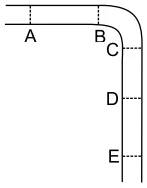
A figura mostra o painel de instrumentos de um automóvel em - FGV 2016
Física - 2016A figura mostra o painel de instrumentos de um automóvel em movimento. Os maiores medidores são: à esquerda, o tacômetro (conta-giros do motor), e à direita, o velocímetro.
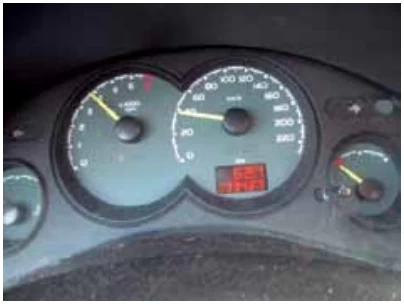
Não está longe a época em que aviões poderão voar a - FGV 2016
Física - 2016Não está longe a época em que aviões poderão voar a velocidades da ordem de grandeza da velocidade da luz (c) no vácuo.
Inicialmente, Mariana foi se divertir no balanço. Solta, do - FGV 2016
Física - 2016O texto a seguir refere-se à questão
Criança feliz é aquela que brinca, fato mais do que comprovado na realidade do dia a dia. A brincadeira ativa, a que faz gastar energia, que traz emoção, traz também felicidade. Mariana é uma criança que foi levada por seus pais para se divertir em um parquinho infantil.
Inicialmente, Mariana foi se divertir no balanço. Solta, do repouso, de uma certa altura, ela oscilou entre dois extremos elevados, a partir dos quais iniciou o retorno até o extremo oposto. Imagine-a no extremo da direita como na figura.

A nave americana New Horizons passou, recentemente, bem - FGV 2016
Física - 2016O texto a seguir refere-se à questão
Criança feliz é aquela que brinca, fato mais do que comprovado na realidade do dia a dia. A brincadeira ativa, a que faz gastar energia, que traz emoção, traz também felicidade. Mariana é uma criança que foi levada por seus pais para se divertir em um parquinho infantil.
Nesse parquinho infantil, há dois escorregadores de mesma - FGV 2016
Física - 2016O texto a seguir refere-se à questão
Criança feliz é aquela que brinca, fato mais do que comprovado na realidade do dia a dia. A brincadeira ativa, a que faz gastar energia, que traz emoção, traz também felicidade. Mariana é uma criança que foi levada por seus pais para se divertir em um parquinho infantil.
Nesse parquinho infantil, há dois escorregadores de mesma altura h relativamente ao chão. Um deles é retilíneo (R) e outro é curvilíneo (C) em forma de tobogã, como indica a figura.

Para determinados tipos de pesquisa ou trabalho, cápsulas - FGV 2016
Física - 2016Para determinados tipos de pesquisa ou trabalho, cápsulas tripuladas são enviadas para as profundezas dos oceanos, mares ou lagos. Considere uma dessas cápsulas de forma cilíndrica, de 2,0 m de altura por 2,0 m de diâmetro, com sua base superior a 48 m de profundidade em água de densidade 1,0.103 kg/m3 , em equilíbrio como ilustra a figura.
Dados:A pressão atmosférica no local é de 1,0.105 Pa, e a aceleração da gravidade é de 10 m/s2. Adote π = 3.
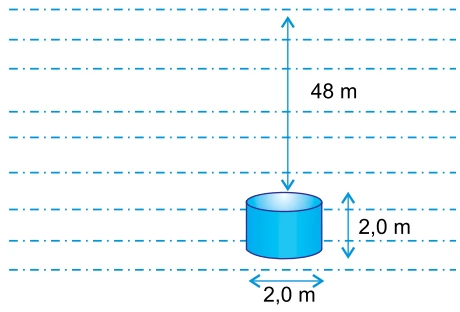
Em uma das oscilações, Mariana partiu do extremo, de uma - FGV 2016
Física - 2016Em uma das oscilações, Mariana partiu do extremo, de uma altura de 80 cm acima do solo e, ao atingir a posição inferior da trajetória, chutou uma bola, de 0,5 kg de massa, que estava parada no solo. A bola adquiriu a velocidade de 24 m/s imediatamente após o chute, na direção horizontal do solo e do movimento da menina. O deslocamento de Mariana, do ponto extremo até o ponto inferior da trajetória, foi realizado sem dissipação de energia mecânica.
Uma pedra de gelo, de 1,0 kg de massa, é retirada de um - FGV 2016
Física - 2016Uma pedra de gelo, de 1,0 kg de massa, é retirada de um ambiente em que se encontrava em equilíbrio térmico a –100°C e recebe 150 kcal de uma fonte de calor. Considerando o calor específico do gelo 0,5 cal/(g.°C), o da água 1,0 cal/(g.°C), e o calor latente de fusão do gelo 80 cal/g,
Sabe-se que a luz branca do Sol, após refratar em um prisma - FGV 2016
Física - 2016Sabe-se que a luz branca do Sol, após refratar em um prisma de acrílico ou de vidro, dispersa-se em um leque de cores, formando o que se chama de espectro. Na figura, representa-se o prisma por P; a tela em que se vê o espectro, por T; e o meio de onde a luz branca veio, por M.

Próximo do final do século XVIII, alguns cientistas (Hertz, - FGV 2016
Física - 2016Próximo do final do século XVIII, alguns cientistas (Hertz, Maxwell, Thomson, Lenard) se envolveram na pesquisa de um certo fenômeno que ficou conhecido como efeito fotoelétrico.
A figura ilustra uma lente biconvexa de cristal, imersa no - FGV 2016
Física - 2016A figura ilustra uma lente biconvexa de cristal, imersa no ar. O seu eixo óptico principal é E.
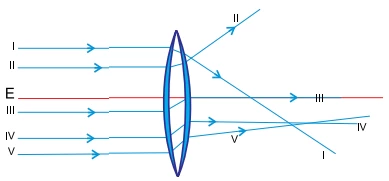
Muitos experimentos importantes para o desenvolvimento - FGV 2016
Física - 2016Muitos experimentos importantes para o desenvolvimento científico ocorreram durante o século XIX. Entre eles, destaca-se a experiência de Millikan, que determinou a relação entre a carga q e a massa m de uma partícula eletrizada e que, posteriormente, levaria à determinação da carga e da massa das partículas elementares. No interior de um recipiente cilíndrico, em que será produzido alto vácuo, duas placas planas e paralelas, ocupando a maior área possível, são mantidas a uma curta distância d, e entre elas é estabelecida uma diferença de potencial elétrico constante U. Variando-se d e U, é possível fazer com que uma partícula de massa m eletrizada com carga q fique equilibrada, mantida em repouso entre as placas. No local da experiência, a aceleração da gravidade é constante de intensidade g.
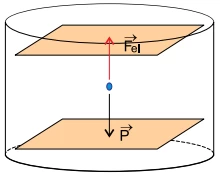
Uma loja tem instaladas, em paralelo, várias lâmpadas - FGV 2016
Física - 2016Uma loja tem instaladas, em paralelo, várias lâmpadas idênticas, cada uma com a especificação: 25 W; 220 V. Logo após a caixa de entrada, há um disjuntor de 10 A protegendo a instalação da loja, especificamente as lâmpadas. O gerente da loja, desconfiado da capacidade do disjuntor, faz algumas operações e chega corretamente ao número máximo de lâmpadas que podem ser acesas simultaneamente, sem desligar o disjuntor.
Uma partícula dotada de massa e eletrizada negativamente é - FGV 2016
Física - 2016Uma partícula dotada de massa e eletrizada negativamente é lançada, com velocidade inicial vo , para o interior de uma região A onde impera um campo elétrico uniforme. A partícula segue a trajetória retilínea paralela ao plano da folha, mostrada na figura. Logo após atravessar a região A, a partícula ingressa na região B, com velocidade v>vo , onde há um campo magnético uniforme, orientado perpendicularmente ao plano da folha, apontando para fora dela.

Na tabela, são apresentadas informações dos rótulos de dois - FGV 2016
Química - 2016Na tabela, são apresentadas informações dos rótulos de dois produtos comercializados por uma indústria alimentícia.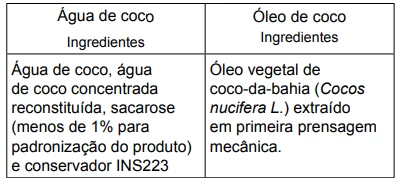
Para melhorar as qualidades nutricionais desses produtos, o fabricante pretende adicionar a cada um deles vitaminas solúveis, tendo como opção aquelas representadas na figura.

Um novo tipo de material especial, seleneto de bismuto, - FGV 2016
Química - 2016Um novo tipo de material especial, seleneto de bismuto, capaz de conduzir eletricidade em sua superfície, não em seu interior, quando em contato com um semicondutor, arseneto de gálio, resulta em um material que conduz eletricidade em várias direções e com níveis de energia diferentes. Esses compostos seguem a fórmula XyYx e suas ligações podem ser consideradas iônicas. Os íons negativos seguem a regra do octeto, enquanto que os íons positivos apresentam a mesma carga que o íon alumínio.
O nitrito de sódio, NaNO2 , é um conservante de alimentos - FGV 2016
Química - 2016O nitrito de sódio, NaNO2 , é um conservante de alimentos processados a partir de carnes e peixes. Os dados de solubilidade deste sal em água são apresentados na tabela.

A medicina tem desenvolvido diversos tratamentos para - FGV 2016
Química - 2016A medicina tem desenvolvido diversos tratamentos para pacientes com câncer de cérebro. Em um deles, o paciente ingere o composto borofenilalanina. Essa molécula que contém o isótopo boro-10 tem afinidade pelas células cerebrais. Após a ingestão, o paciente é submetido a um feixe de nêutrons. Cada isótopo de boro-10 captura um nêutron e forma um isótopo instável que se fissiona em duas espécies menores e emite ainda radiação gama. Dessa maneira, a célula tumoral é atingida pela energia das emissões do processo de fissão e é destruída.
(www.nipe.unicamp.br/enumas/admin/resources/uploads/robertovicente_ hasolucao.pdf. Adaptado)

Os palitos de fósforo são dispositivos simples empregados - FGV 2016
Química - 2016Os palitos de fósforo são dispositivos simples empregados para fazer fogo. A chama se produz por meio de reações que ocorrem com as substâncias da “cabeça” do palito. Quando o palito é esfregado na superfície áspera da lateral da caixa, as substâncias reagem formando Sb2 O5 , KCl e SO2 . Essa reação é muito exotérmica e rápida e promove a reação de combustão e a propagação da chama pela madeira do palito.
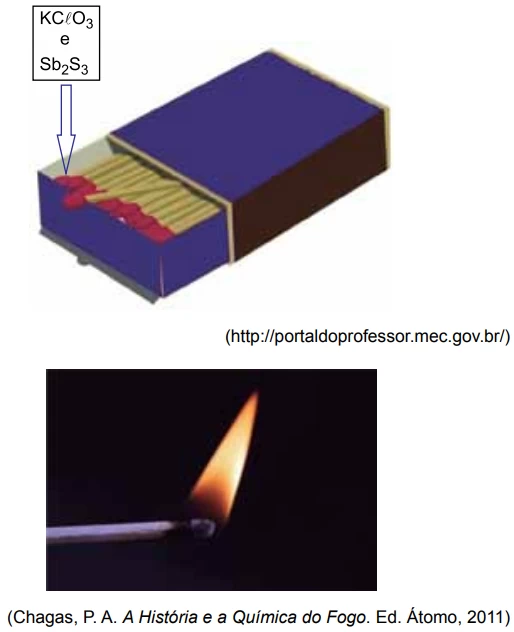
Os valores dos números de oxidação do átomo de nitrogênio - FGV 2016
Química - 2016O texto seguinte refere-se à questão:
O ácido nítrico é um importante insumo para produção de fertilizantes, explosivos e tintas. Sua produção industrial é feita pelo processo Ostwald, em três etapas que podem ser representadas pelas reações:

No processo Ostwald, a produção de 2,00 x 106 mol de HNO3 - FGV 2016
Química - 2016O texto seguinte refere-se à questão:
O ácido nítrico é um importante insumo para produção de fertilizantes, explosivos e tintas. Sua produção industrial é feita pelo processo Ostwald, em três etapas que podem ser representadas pelas reações:

Em um experimento em laboratório de química, montou-se uma - FVG 2016
Química - 2016Em um experimento em laboratório de química, montou-se uma célula eletrolítica de acordo com o esquema:

Usaram-se como eletrodo dois bastões de grafite, uma solução aquosa 1,0 mol.L–1 de CuSO4 em meio ácido a 20 o C e uma pilha.
Alguns minutos, após iniciado o experimento, observaram-se a formação de um sólido de coloração amarronzada sobre a superfície do eletrodo de polo negativo e a formação de bolhas na superfície do eletrodo de polo positivo.
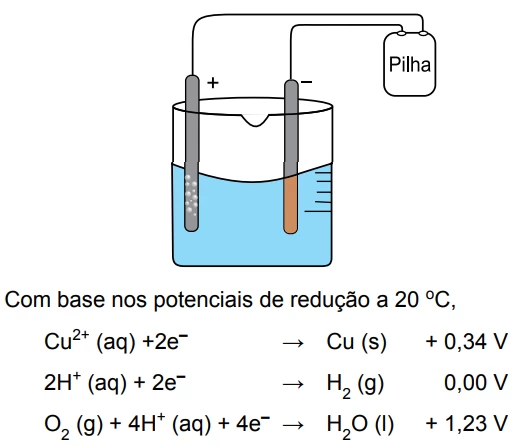
Uma indústria gera por mês 103 m3 de efluentes contendo - FGV 2016
Química - 2016O texto seguinte refere-se à questão:
O fenol é um composto químico altamente tóxico encontrado em efluentes (resíduos aquosos de processos químicos) de variadas indústrias como a farmacêutica, de tintas e de papel e celulose.
O fenol se ioniza em água de acordo com o equilíbrio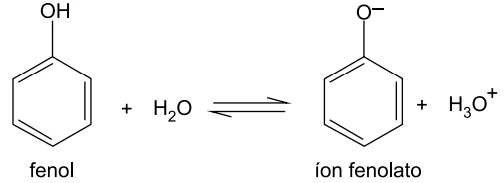
A concentração máxima permitida para fenóis em águas não cloradas é de 0,1 mg/L. Contudo, em águas cloradas, a concentração máxima permitida para fenóis pela resolução n.o 357 do CONAMA é de 0,003 mg/L.
Os químicos do laboratório de análises de uma indústria de - FGV 2016
Química - 2016O texto seguinte refere-se à questão:
O fenol é um composto químico altamente tóxico encontrado em efluentes (resíduos aquosos de processos químicos) de variadas indústrias como a farmacêutica, de tintas e de papel e celulose.
O fenol se ioniza em água de acordo com o equilíbrio
A concentração máxima permitida para fenóis em águas não cloradas é de 0,1 mg/L. Contudo, em águas cloradas, a concentração máxima permitida para fenóis pela resolução n.o 357 do CONAMA é de 0,003 mg/L.
O hidrogênio para células a combustível de uso automotivo - FGV 2016
Química - 2016O hidrogênio para células a combustível de uso automotivo poderá ser obtido futuramente a partir da reação de reforma do etanol. Atualmente, nessa reação, são gerados subprodutos indesejados: etanal (I) e etanoato de etila (II). Porém, pesquisadores da UNESP de Araraquara verificaram que, com o uso de um catalisador adequado, a produção de hidrogênio do etanol poderá ser viabilizada sem subprodutos.
Um certo polímero é produzido a partir de um monômero, que - FGV 2016
Química - 2016Um certo polímero é produzido a partir de um monômero, que é um hidrocarboneto que contém somente uma instauração. A análise elementar por combustão completa de 0,5 mol de moléculas desse hidrocarboneto resultou em 1,5 mol de moléculas de CO2 .
Os polímeros biodegradáveis podem ser empregados na - FGV 2016
Química - 2016Os polímeros biodegradáveis podem ser empregados na confecção de sacolas plásticas utilizadas nos supermercados. Esses polímeros apresentam estruturas de cadeias alifáticas com grupos funcionais hidrolisáveis.
O coque é um dos produtos da transformação do carvão - FGV 2016
Química - 2016O coque é um dos produtos da transformação do carvão mineral e é empregado para obtenção de metais em indústrias siderúrgicas. A coqueria é a unidade de processo onde o carvão mineral é aquecido na ausência de oxigênio. Esse processo se denomina __________. Nele, são separados componentes mais voláteis, e o resíduo sólido final tem __________ teor percentual de carbono do que o carvão mineral. O coque é adicionado ao alto forno no processo de redução do minério para produção de __________.
Levando em consideração os elementos verbais e não verbais - FGV 2016
Língua Portuguesa - 2016Leia a tira para responder à questão
O processo pelo qual deriva a palavra “colaterais” e o - FGV 2016
Língua Portuguesa - 2016Leia a tira para responder à questão

De acordo com a norma-padrão, completam-se as lacunas do - FGV 2016
Língua Portuguesa - 2016Peça-chave em qualquer economia desenvolvida, a moeda americana __________ pode significar um perigo. A excessiva valorização do dólar já provoca mudanças de hábitos de consumo da classe média. Nos últimos anos, muitos brasileiros viajaram para os Estados Unidos para – além de aproveitar as férias – pagar mais barato por artigos eletrônicos, utilidades domésticas, roupas e acessórios para bebês, entre outros itens. Mas, pela primeira vez em muito tempo, está deixando de ser vantajoso __________ das férias e fechar negócios em solo americano. Em economias abertas como a brasileira, que dependem do fluxo de comércio internacional, a alta do dólar __________ uma série de prejuízos.
(IstoÉ, 19.08.2015. Adaptado)
Considere o trecho: “Nos últimos anos, muitos brasileiros - FGV 2016
Língua Portuguesa - 2016Peça-chave em qualquer economia desenvolvida, a moeda americana __________ pode significar um perigo. A excessiva valorização do dólar já provoca mudanças de hábitos de consumo da classe média. Nos últimos anos, muitos brasileiros viajaram para os Estados Unidos para – além de aproveitar as férias – pagar mais barato por artigos eletrônicos, utilidades domésticas, roupas e acessórios para bebês, entre outros itens. Mas, pela primeira vez em muito tempo, está deixando de ser vantajoso __________ das férias e fechar negócios em solo americano. Em economias abertas como a brasileira, que dependem do fluxo de comércio internacional, a alta do dólar __________ uma série de prejuízos.
(IstoÉ, 19.08.2015. Adaptado)
No contexto em que está empregada, a expressão “com a - FGV 2016
Língua Portuguesa - 2016Leia a manchete.

Ao discutir a adoção do euro como moeda entre os países - FGV 2016
Língua Portuguesa - 2016Leia o texto para responder à questão
Na virada do século, chegou o euro. Na prática, era como se o marco alemão mudasse de nome para “euro” e passasse a suprir o resto do continente (a maior parte dele, pelo menos). Parecia bom para todas as partes. Os governos dos países menos pibados passariam a receber os impostos dos seus cidadãos em euros, uma moeda garantida pelo PIB alemão. Impostos servem para pagar as dívidas dos governos – além da lagosta dos governantes. E agora os contribuintes pagavam em euros. Resultado: o mercado passou a emprestar para os países bagunçados da Europa a juros baixíssimos.
Aí choveu euro na periferia da Europa. A economia ali cresceu como nunca, mas os governantes gastaram como sempre. Além disso, não perceberam que seus países eram pequenos demais para suportar o peso de uma moeda forte. Com os PIBs dos europobres caindo, a arrecadação deles diminuiu. Menos arrecadação, mais problemas para pagar dívidas. Aí tome mais dinheiro emprestado para ir rolando a pendura, só que agora a juros menos fofos.
(Superinteressante, agosto de 2015. Adaptado)
Assinale a alternativa em que a referência ao PIB confere - FGV 2016
Língua Portuguesa - 2016Leia o texto para responder à questão
Na virada do século, chegou o euro. Na prática, era como se o marco alemão mudasse de nome para “euro” e passasse a suprir o resto do continente (a maior parte dele, pelo menos). Parecia bom para todas as partes. Os governos dos países menos pibados passariam a receber os impostos dos seus cidadãos em euros, uma moeda garantida pelo PIB alemão. Impostos servem para pagar as dívidas dos governos – além da lagosta dos governantes. E agora os contribuintes pagavam em euros. Resultado: o mercado passou a emprestar para os países bagunçados da Europa a juros baixíssimos.
Aí choveu euro na periferia da Europa. A economia ali cresceu como nunca, mas os governantes gastaram como sempre. Além disso, não perceberam que seus países eram pequenos demais para suportar o peso de uma moeda forte. Com os PIBs dos europobres caindo, a arrecadação deles diminuiu. Menos arrecadação, mais problemas para pagar dívidas. Aí tome mais dinheiro emprestado para ir rolando a pendura, só que agora a juros menos fofos.
(Superinteressante, agosto de 2015. Adaptado)
De acordo com a norma-padrão, assinale a alternativa - FGV 2016
Língua Portuguesa - 2016Leia o texto para responder à questão
Na virada do século, chegou o euro. Na prática, era como se o marco alemão mudasse de nome para “euro” e passasse a suprir o resto do continente (a maior parte dele, pelo menos). Parecia bom para todas as partes. Os governos dos países menos pibados passariam a receber os impostos dos seus cidadãos em euros, uma moeda garantida pelo PIB alemão. Impostos servem para pagar as dívidas dos governos – além da lagosta dos governantes. E agora os contribuintes pagavam em euros. Resultado: o mercado passou a emprestar para os países bagunçados da Europa a juros baixíssimos.
Aí choveu euro na periferia da Europa. A economia ali cresceu como nunca, mas os governantes gastaram como sempre. Além disso, não perceberam que seus países eram pequenos demais para suportar o peso de uma moeda forte. Com os PIBs dos europobres caindo, a arrecadação deles diminuiu. Menos arrecadação, mais problemas para pagar dívidas. Aí tome mais dinheiro emprestado para ir rolando a pendura, só que agora a juros menos fofos.
(Superinteressante, agosto de 2015. Adaptado)
Assinale a alternativa em que a passagem está reescrita, - FGV 2016
Língua Portuguesa - 2016Leia o texto para responder à questão
O velho Lima
O velho Lima, que era empregado – empregado antigo – numa das nossas repartições públicas, e morava no Engenho de Dentro, caiu de cama, seriamente enfermo, no dia 14 de novembro de 1889, isto é, na véspera da Proclamação da República dos Estados Unidos do Brasil.
O doente não considerou a moléstia coisa de cuidado, e tanto assim foi que não quis médico. Entretanto, o velho Lima esteve de molho oito dias.
O nosso homem tinha o hábito de não ler jornais e, como em casa nada lhe dissessem (porque nada sabiam), ele ignorava completamente que o Império se transformara em República.
No dia 23, restabelecido e pronto para outra, comprou um bilhete, segundo o seu costume, e tomou lugar no trem, ao lado do comendador Vidal, que o recebeu com estas palavras:
– Bom dia, cidadão.
O velho Lima estranhou o cidadão, mas de si para si pensou que o comendador dissera aquilo como poderia ter dito ilustre, e não deu maior importância ao cumprimento, limitando-se a responder:
– Bom dia, comendador.
– Qual comendador! Chama-me Vidal! Já não há mais comendadores!
– Ora essa! Então por quê?
– A República deu cabo de todas as comendas! Acabaram-se!
O velho Lima encarou o comendador e calou-se, receoso de não ter compreendido a pilhéria.
Ao entrar na sua seção, o velho Lima sentou-se e viu que tinham tirado da parede uma velha litografia representando D. Pedro de Alcântara. Como na ocasião passasse um contínuo, perguntou-lhe:
– Por que tiraram da parede o retrato de Sua Majestade?
O contínuo respondeu num tom lentamente desdenhoso:
– Ora, cidadão, que fazia ali a figura do Pedro Banana?
– Pedro Banana! – repetiu raivoso o velho Lima.
– Não dou três anos para que isso seja República!
(Arthur Azevedo. Seleção de contos, 2014)
Nas passagens “– A República deu cabo de todas as comendas! - FGV 2016
Língua Portuguesa - 2016Leia o texto para responder à questão
O velho Lima
O velho Lima, que era empregado – empregado antigo – numa das nossas repartições públicas, e morava no Engenho de Dentro, caiu de cama, seriamente enfermo, no dia 14 de novembro de 1889, isto é, na véspera da Proclamação da República dos Estados Unidos do Brasil.
O doente não considerou a moléstia coisa de cuidado, e tanto assim foi que não quis médico. Entretanto, o velho Lima esteve de molho oito dias.
O nosso homem tinha o hábito de não ler jornais e, como em casa nada lhe dissessem (porque nada sabiam), ele ignorava completamente que o Império se transformara em República.
No dia 23, restabelecido e pronto para outra, comprou um bilhete, segundo o seu costume, e tomou lugar no trem, ao lado do comendador Vidal, que o recebeu com estas palavras:
– Bom dia, cidadão.
O velho Lima estranhou o cidadão, mas de si para si pensou que o comendador dissera aquilo como poderia ter dito ilustre, e não deu maior importância ao cumprimento, limitando-se a responder:
– Bom dia, comendador.
– Qual comendador! Chama-me Vidal! Já não há mais comendadores!
– Ora essa! Então por quê?
– A República deu cabo de todas as comendas! Acabaram-se!
O velho Lima encarou o comendador e calou-se, receoso de não ter compreendido a pilhéria.
Ao entrar na sua seção, o velho Lima sentou-se e viu que tinham tirado da parede uma velha litografia representando D. Pedro de Alcântara. Como na ocasião passasse um contínuo, perguntou-lhe:
– Por que tiraram da parede o retrato de Sua Majestade?
O contínuo respondeu num tom lentamente desdenhoso:
– Ora, cidadão, que fazia ali a figura do Pedro Banana?
– Pedro Banana! – repetiu raivoso o velho Lima.
– Não dou três anos para que isso seja República!
(Arthur Azevedo. Seleção de contos, 2014)
Observe os trechos do texto: • ... no dia 14 de novembro - FGV 2016
Língua Portuguesa - 2016Leia o texto para responder à questão
O velho Lima
O velho Lima, que era empregado – empregado antigo – numa das nossas repartições públicas, e morava no Engenho de Dentro, caiu de cama, seriamente enfermo, no dia 14 de novembro de 1889, isto é, na véspera da Proclamação da República dos Estados Unidos do Brasil.
O doente não considerou a moléstia coisa de cuidado, e tanto assim foi que não quis médico. Entretanto, o velho Lima esteve de molho oito dias.
O nosso homem tinha o hábito de não ler jornais e, como em casa nada lhe dissessem (porque nada sabiam), ele ignorava completamente que o Império se transformara em República.
No dia 23, restabelecido e pronto para outra, comprou um bilhete, segundo o seu costume, e tomou lugar no trem, ao lado do comendador Vidal, que o recebeu com estas palavras:
– Bom dia, cidadão.
O velho Lima estranhou o cidadão, mas de si para si pensou que o comendador dissera aquilo como poderia ter dito ilustre, e não deu maior importância ao cumprimento, limitando-se a responder:
– Bom dia, comendador.
– Qual comendador! Chama-me Vidal! Já não há mais comendadores!
– Ora essa! Então por quê?
– A República deu cabo de todas as comendas! Acabaram-se!
O velho Lima encarou o comendador e calou-se, receoso de não ter compreendido a pilhéria.
Ao entrar na sua seção, o velho Lima sentou-se e viu que tinham tirado da parede uma velha litografia representando D. Pedro de Alcântara. Como na ocasião passasse um contínuo, perguntou-lhe:
– Por que tiraram da parede o retrato de Sua Majestade?
O contínuo respondeu num tom lentamente desdenhoso:
– Ora, cidadão, que fazia ali a figura do Pedro Banana?
– Pedro Banana! – repetiu raivoso o velho Lima.
– Não dou três anos para que isso seja República!
(Arthur Azevedo. Seleção de contos, 2014)
Assinale a alternativa em que a passagem está reescrita, de - FGV 2016
Língua Portuguesa - 2016Leia o texto para responder à questão
O velho Lima
O velho Lima, que era empregado – empregado antigo – numa das nossas repartições públicas, e morava no Engenho de Dentro, caiu de cama, seriamente enfermo, no dia 14 de novembro de 1889, isto é, na véspera da Proclamação da República dos Estados Unidos do Brasil.
O doente não considerou a moléstia coisa de cuidado, e tanto assim foi que não quis médico. Entretanto, o velho Lima esteve de molho oito dias.
O nosso homem tinha o hábito de não ler jornais e, como em casa nada lhe dissessem (porque nada sabiam), ele ignorava completamente que o Império se transformara em República.
No dia 23, restabelecido e pronto para outra, comprou um bilhete, segundo o seu costume, e tomou lugar no trem, ao lado do comendador Vidal, que o recebeu com estas palavras:
– Bom dia, cidadão.
O velho Lima estranhou o cidadão, mas de si para si pensou que o comendador dissera aquilo como poderia ter dito ilustre, e não deu maior importância ao cumprimento, limitando-se a responder:
– Bom dia, comendador.
– Qual comendador! Chama-me Vidal! Já não há mais comendadores!
– Ora essa! Então por quê?
– A República deu cabo de todas as comendas! Acabaram-se!
O velho Lima encarou o comendador e calou-se, receoso de não ter compreendido a pilhéria.
Ao entrar na sua seção, o velho Lima sentou-se e viu que tinham tirado da parede uma velha litografia representando D. Pedro de Alcântara. Como na ocasião passasse um contínuo, perguntou-lhe:
– Por que tiraram da parede o retrato de Sua Majestade?
O contínuo respondeu num tom lentamente desdenhoso:
– Ora, cidadão, que fazia ali a figura do Pedro Banana?
– Pedro Banana! – repetiu raivoso o velho Lima.
– Não dou três anos para que isso seja República!
(Arthur Azevedo. Seleção de contos, 2014)
A leitura do poema permite concluir que o verão carioca (A) - FGV 2016
Língua Portuguesa - 2016Leia o poema para responder à questão
Verão carioca 73
O carro do sol passeia rodas de incêndio
sobre os corpos e as mentes, fulminando-os.
Restam, sob o massacre, esquírolas1 de consciência,
a implorar, sem esperança, um caneco de sombra.
As árvores decotadas, alamedas sem árvores.
O ar é neutro, fixo, e recusa passagem
às viaturas da brisa. O zinir de besouros buzinas
ressoa no interior da célula ferida.
Sobe do negro chão meloso espedaçado
o súlfur2 dos avernos3 em pescoções de fogo.
A vida, esse lagarto invisível na loca4,
ou essa rocha ardendo onde a verdura ria?
O mar abre-se em leque à visita de uns milhares,
mas, curvados ao peso dessa carga de chamas,
em mil formas de esforço e pobreza e rotina, milhões
curtem a maldição do esplêndido verão.
(Carlos Drummond de Andrade. As impurezas do branco, 2012)
1 esquírolas: lascas, pedacinhos
2 súlfur: enxofre
3 avernos: infernos
4 loca: gruta pequena, local sob algo
As definições são exemplificadas, respectivamente, com os - FGV 2016
Língua Portuguesa - 2016Leia o poema para responder à questão
Verão carioca 73
O carro do sol passeia rodas de incêndio
sobre os corpos e as mentes, fulminando-os.
Restam, sob o massacre, esquírolas1 de consciência,
a implorar, sem esperança, um caneco de sombra.
As árvores decotadas, alamedas sem árvores.
O ar é neutro, fixo, e recusa passagem
às viaturas da brisa. O zinir de besouros buzinas
ressoa no interior da célula ferida.
Sobe do negro chão meloso espedaçado
o súlfur2 dos avernos3 em pescoções de fogo.
A vida, esse lagarto invisível na loca4,
ou essa rocha ardendo onde a verdura ria?
O mar abre-se em leque à visita de uns milhares,
mas, curvados ao peso dessa carga de chamas,
em mil formas de esforço e pobreza e rotina, milhões
curtem a maldição do esplêndido verão.
(Carlos Drummond de Andrade. As impurezas do branco, 2012)
1 esquírolas: lascas, pedacinhos
2 súlfur: enxofre
3 avernos: infernos
4 loca: gruta pequena, local sob algo
Considere as definições:
– Metáfora é a figura de linguagem que consiste no emprego de uma palavra com sentido que não lhe é comum ou próprio, sendo esse novo sentido resultante de uma relação de semelhança, de intersecção entre dois termos.
– Personificação ou prosopopeia é a figura de linguagem que consiste em atribuir linguagem, sentimentos e ações próprios dos seres humanos a seres inanimados ou irracionais.
– Aliteração é a repetição constante de um mesmo fonema consonantal.
(William Roberto Cereja e Thereza Cochar Magalhães. Gramática reflexiva, 2005)
Assinale a alternativa em que os versos da primeira estrofe - FGV 2016
Língua Portuguesa - 2016Leia o poema para responder à questão
Verão carioca 73
O carro do sol passeia rodas de incêndio
sobre os corpos e as mentes, fulminando-os.
Restam, sob o massacre, esquírolas1 de consciência,
a implorar, sem esperança, um caneco de sombra.
As árvores decotadas, alamedas sem árvores.
O ar é neutro, fixo, e recusa passagem
às viaturas da brisa. O zinir de besouros buzinas
ressoa no interior da célula ferida.
Sobe do negro chão meloso espedaçado
o súlfur2 dos avernos3 em pescoções de fogo.
A vida, esse lagarto invisível na loca4,
ou essa rocha ardendo onde a verdura ria?
O mar abre-se em leque à visita de uns milhares,
mas, curvados ao peso dessa carga de chamas,
em mil formas de esforço e pobreza e rotina, milhões
curtem a maldição do esplêndido verão.
(Carlos Drummond de Andrade. As impurezas do branco, 2012)
1 esquírolas: lascas, pedacinhos
2 súlfur: enxofre
3 avernos: infernos
4 loca: gruta pequena, local sob algo
Quantos são os valores inteiros de x que satisfazem –2 ≤ 2x - FGV 2016
Matemática - 2016Quantos são os valores inteiros de x
Dada a função f(x) = x2 + 3, qual o valor da expressão - FGV 2016
Matemática - 2016Dada a função f(x) = x2 + 3,
Em determinado período em que 1 dólar valia R$3,20, o custo - FGV 2016
Matemática - 2016Em determinado período em que 1 dólar valia R$3,20, o custo de produção em reais de um bem exportável era assim constituído: 20% em matéria-prima e 80% em mão de obra.
A equação polinomial x3 + 12x2 – 96x – 512 = 0 tem raízes - FGV 2016
Matemática - 2016A equação polinomial x3 + 12x2 – 96x – 512 = 0 tem raízes reais em progressão geométrica quando colocadas em ordem crescente de seus valores absolutos.
Ronaldo aplicou seu patrimônio em dois fundos de - FGV 2016
Matemática - 2016Ronaldo aplicou seu patrimônio em dois fundos de investimentos, A e B.
No período de um ano ele teve um rendimento de R$ 26 250,00 aplicando 75% de seu patrimônio em A e 25% em B.
Um triângulo isósceles tem a base medindo 10 e um dos - FGV 2016
Matemática - 2016Um triângulo isósceles tem a base medindo 10 e um dos ângulos da base medindo 45°.
Sejam 0 e 1 dois anos consecutivos. Em um país sem inflação - FGV 2016
Matemática - 2016Sejam 0 e 1 dois anos consecutivos. Em um país sem inflação, suponha que no ano 0 o PIB ( Produto Interno Bruto) seja 1000 e a dívida pública seja 600; portanto a relação dívida/PIB é 600/1000, ou seja 60%. Se o PIB crescer 2% ao ano e a taxa de juros da dívida pública for 4% ao ano, quanto o governo deverá economizar (isto é, ter um superávit de receitas menos despesas) no ano 1 para que a relação dívida/PIB fique estabilizada em 60%?
A quantidade mensalmente vendida x, em toneladas, de certo - FGV 2016
Matemática - 2016A quantidade mensalmente vendida x, em toneladas, de certo produto, relaciona-se com seu preço por tonelada p, em reais, através da equação p = 2 000 – 0,5x.
O custo de produção mensal em reais desse produto é função da quantidade em toneladas produzidas x, mediante a relação C = 500 000 + 800 x .
O comprimento do segmento determinado pelos pontos de - FGV 2016
Matemática - 2016O comprimento do segmento determinado pelos pontos de intersecção das parábolas de equações
Ao aplicar hoje 100 mil reais a juros compostos a uma taxa - FGV 2016
Matemática - 2016Ao aplicar hoje 100 mil reais a juros compostos a uma taxa de juros anual positiva, Jaime receberá 60 mil reais daqui a um ano e 55 mil reais daqui a dois anos.
Os pontos de coordenadas ( x , y ) do plano cartesiano que - FGV 2016
Matemática - 2016Os pontos de coordenadas ( x , y ) do plano cartesiano que satisfazem a equação matricial
O ponto da reta x – 3y = 5 que é mais próximo ao ponto (1, - FGV 2016
Matemática - 2016O ponto da reta x – 3y = 5 que é mais próximo ao ponto
A urna I tem duas bolas vermelhas, a urna II tem duas bolas - FGV 2016
Matemática - 2016A urna I tem duas bolas vermelhas, a urna II tem duas bolas brancas e a urna III tem uma bola branca e outra vermelha.
Sorteia-se uma urna e dela uma bola.
Considere o conjunto dos 51 primeiros múltiplos - FGV 2016
Matemática - 2016Considere o conjunto dos 51 primeiros múltiplos positivos de 3. Seja μ sua média e M sua mediana.
FGV 2016 - A soma dos montantes de n depósitos anuais, de - FGV 2016
Matemática - 2016A soma dos montantes de n depósitos anuais, de valor R cada um, feitos nos anos 1, 2, 3 ... n a juros compostos e à taxa de juros anual i, calculados na data n, é dada pela fórmula:

Tendo em vista a reação do garçom, dentre as palavras - FGV 2016
Língua Portuguesa - 2016Examine este cartum:
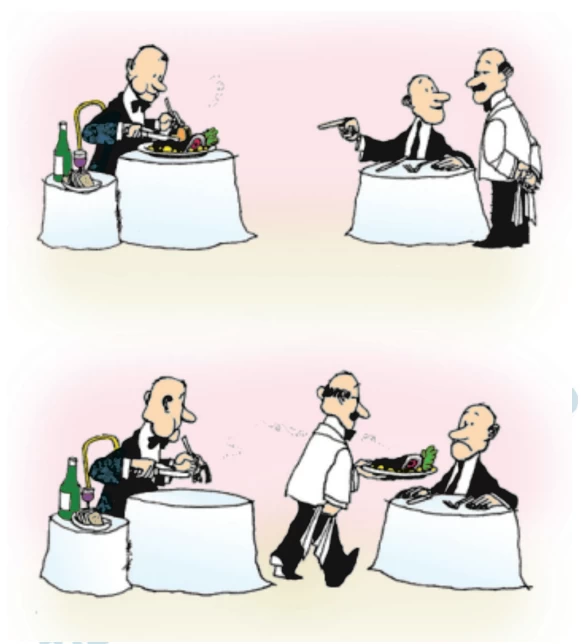
A frase que expressa corretamente a opinião do autor sobre - FGV 2016
Língua Portuguesa - 2016Para responder a questão, leia o seguinte texto, escrito poucos dias antes do início da última Copa do Mundo.
A tão falada lição
Passam os anos menos depressa do que dizem, quando dizem que o tempo corre. Passam mais depressa do que se pensa, quando se trata de vivê-los. São 64 anos. Por exemplo, entre este e 1950, ano de muitas agitações.
Na política, pela volta de Getúlio, se não para redimir-se da ditadura encerrada cinco anos antes, porque ditadura nenhuma tem redenção, para um governo que, mesmo inconcluído, legou ao Brasil os instrumentos que permitiriam fazer o grande país que não foi feito – Petrobras, BNDE, uma infinidade de outros.
Entre tantas agitações mais, lá estava a Copa do Mundo, a primeira depois da Segunda Guerra Mundial, no maior estádio do mundo, para fazer dos brasileiros os campeões mundiais.
Nos 64 anos seguintes, Getúlio e seu governo desapareceram sob a dureza das versões degradantes e do getulismo mitológico. A Copa e seu final desastroso satisfizeram-se com explicação única e simples: fora do campo, os excessos da autoglorificação antecipada, com louvações e festejos movidos a políticos, artistas, jornalistas, a publicidade comercial; e, no campo, uma (inexistente) falha do goleiro das cores pátrias.
Há 64 anos se repete essa ladainha de 50, como símbolo e como advertência. Quem quiser uma ideia melhor da explicação dada a 50, é fácil. Basta uma olhadela nos jornais e na TV, a gente da TV e outras gentes em visita à “concentração”, a caçada a jogadores, convidados VIP para ver treinos, lá vai a estatueta ao palácio presidencial, os comandantes Felipão e Parreira são claros: “Nós já estamos com uma mão na taça”. Igualzinho. Está nos genes.
Janio de Freitas, Folha de S.Paulo, 03/06/2014. Adaptado.
Analise as seguintes afirmações sobre o texto: I) Segundo o - FGV 2016
Língua Portuguesa - 2016Para responder a questão, leia o seguinte texto, escrito poucos dias antes do início da última Copa do Mundo.
A tão falada lição
Passam os anos menos depressa do que dizem, quando dizem que o tempo corre. Passam mais depressa do que se pensa, quando se trata de vivê-los. São 64 anos. Por exemplo, entre este e 1950, ano de muitas agitações.
Na política, pela volta de Getúlio, se não para redimir-se da ditadura encerrada cinco anos antes, porque ditadura nenhuma tem redenção, para um governo que, mesmo inconcluído, legou ao Brasil os instrumentos que permitiriam fazer o grande país que não foi feito – Petrobras, BNDE, uma infinidade de outros.
Entre tantas agitações mais, lá estava a Copa do Mundo, a primeira depois da Segunda Guerra Mundial, no maior estádio do mundo, para fazer dos brasileiros os campeões mundiais.
Nos 64 anos seguintes, Getúlio e seu governo desapareceram sob a dureza das versões degradantes e do getulismo mitológico. A Copa e seu final desastroso satisfizeram-se com explicação única e simples: fora do campo, os excessos da autoglorificação antecipada, com louvações e festejos movidos a políticos, artistas, jornalistas, a publicidade comercial; e, no campo, uma (inexistente) falha do goleiro das cores pátrias.
Há 64 anos se repete essa ladainha de 50, como símbolo e como advertência. Quem quiser uma ideia melhor da explicação dada a 50, é fácil. Basta uma olhadela nos jornais e na TV, a gente da TV e outras gentes em visita à “concentração”, a caçada a jogadores, convidados VIP para ver treinos, lá vai a estatueta ao palácio presidencial, os comandantes Felipão e Parreira são claros: “Nós já estamos com uma mão na taça”. Igualzinho. Está nos genes.
Janio de Freitas, Folha de S.Paulo, 03/06/2014. Adaptado.
Acerca dos seguintes pronomes presentes nos dois primeiros - FGV 2016
Língua Portuguesa - 2016Para responder a questão, leia o seguinte texto, escrito poucos dias antes do início da última Copa do Mundo.
A tão falada lição
Passam os anos menos depressa do que dizem, quando dizem que o tempo corre. Passam mais depressa do que se pensa, quando se trata de vivê-los. São 64 anos. Por exemplo, entre este e 1950, ano de muitas agitações.
Na política, pela volta de Getúlio, se não para redimir-se da ditadura encerrada cinco anos antes, porque ditadura nenhuma tem redenção, para um governo que, mesmo inconcluído, legou ao Brasil os instrumentos que permitiriam fazer o grande país que não foi feito – Petrobras, BNDE, uma infinidade de outros.
Entre tantas agitações mais, lá estava a Copa do Mundo, a primeira depois da Segunda Guerra Mundial, no maior estádio do mundo, para fazer dos brasileiros os campeões mundiais.
Nos 64 anos seguintes, Getúlio e seu governo desapareceram sob a dureza das versões degradantes e do getulismo mitológico. A Copa e seu final desastroso satisfizeram-se com explicação única e simples: fora do campo, os excessos da autoglorificação antecipada, com louvações e festejos movidos a políticos, artistas, jornalistas, a publicidade comercial; e, no campo, uma (inexistente) falha do goleiro das cores pátrias.
Há 64 anos se repete essa ladainha de 50, como símbolo e como advertência. Quem quiser uma ideia melhor da explicação dada a 50, é fácil. Basta uma olhadela nos jornais e na TV, a gente da TV e outras gentes em visita à “concentração”, a caçada a jogadores, convidados VIP para ver treinos, lá vai a estatueta ao palácio presidencial, os comandantes Felipão e Parreira são claros: “Nós já estamos com uma mão na taça”. Igualzinho. Está nos genes.
Janio de Freitas, Folha de S.Paulo, 03/06/2014. Adaptado.
Segundo o texto, a única informação sobre Manuel Antônio de - FGV 2016
Língua Portuguesa - 2016Texto para a questão
À margem de Memórias de um sargento de milícias
É difícil associar à impressão deixada por essa obra divertida e leve a ideia de um destino trágico. Foi, entretanto, o que coube a Manuel Antônio de Almeida, nascido em 1831 e morto em 1861. A simples justaposição dessas duas datas é bastante reveladora: mais alguns dados, os poucos de que dispomos, apenas servem para carregar nas cores, para tornar a atmosfera do quadro mais deprimente. Que é que cabe num prazo tão curto?
Uma vida toda em movimento, uma série tumultuosa de lutas, malogros e reerguimentos, as reações de uma vontade forte contra os golpes da fatalidade, os heroicos esforços de ascensão de um self-made man esmagado pelas circunstâncias. Ignoramos quase totalmente seus começos de menino pobre, mas talvez seja possível reconstruí-los em parte pelas cenas tão vivas em que apresenta o garoto Leonardo lançado de chofre nas ruas pitorescas da indolente cidadezinha que era o Rio daquela época. Basta enumerar todas as profissões que o escritor exerceu em seguida para adivinhar o ambiente. Estudante na Escola de Belas-Artes e na Faculdade de Medicina, jornalista e tradutor, membro fundador da Sociedade das Belas-Artes, administrador da Tipografia Nacional, diretor da Academia Imperial da Ópera Nacional, Manuel Antônio provavelmente não se teria candidatado ainda a uma cadeira da Assembleia Provincial se suas ocupações sucessivas lhe garantissem uma renda proporcional ao brilho de seus títulos. Achava-se justamente a caminho da “sua” circunscrição, quando, depois de tantos naufrágios no sentido figurado, pereceu num naufrágio concreto, deixando saudades a um reduzido círculo de amigos, um medíocre libreto de ópera e algumas traduções, do francês, de romances de cordel, aos pesquisadores de curiosidade, e as Memórias de um sargento de milícias ao seu país.
Paulo Rónai, Encontros com o Brasil.
Rio de Janeiro: Edições de Janeiro, 2014.
No trecho “depois de tantos naufrágios no sentido figura - FGV 2016
Língua Portuguesa - 2016Texto para a questão
À margem de Memórias de um sargento de milícias
É difícil associar à impressão deixada por essa obra divertida e leve a ideia de um destino trágico. Foi, entretanto, o que coube a Manuel Antônio de Almeida, nascido em 1831 e morto em 1861. A simples justaposição dessas duas datas é bastante reveladora: mais alguns dados, os poucos de que dispomos, apenas servem para carregar nas cores, para tornar a atmosfera do quadro mais deprimente. Que é que cabe num prazo tão curto?
Uma vida toda em movimento, uma série tumultuosa de lutas, malogros e reerguimentos, as reações de uma vontade forte contra os golpes da fatalidade, os heroicos esforços de ascensão de um self-made man esmagado pelas circunstâncias. Ignoramos quase totalmente seus começos de menino pobre, mas talvez seja possível reconstruí-los em parte pelas cenas tão vivas em que apresenta o garoto Leonardo lançado de chofre nas ruas pitorescas da indolente cidadezinha que era o Rio daquela época. Basta enumerar todas as profissões que o escritor exerceu em seguida para adivinhar o ambiente. Estudante na Escola de Belas-Artes e na Faculdade de Medicina, jornalista e tradutor, membro fundador da Sociedade das Belas-Artes, administrador da Tipografia Nacional, diretor da Academia Imperial da Ópera Nacional, Manuel Antônio provavelmente não se teria candidatado ainda a uma cadeira da Assembleia Provincial se suas ocupações sucessivas lhe garantissem uma renda proporcional ao brilho de seus títulos. Achava-se justamente a caminho da “sua” circunscrição, quando, depois de tantos naufrágios no sentido figurado, pereceu num naufrágio concreto, deixando saudades a um reduzido círculo de amigos, um medíocre libreto de ópera e algumas traduções, do francês, de romances de cordel, aos pesquisadores de curiosidade, e as Memórias de um sargento de milícias ao seu país.
Paulo Rónai, Encontros com o Brasil.
Rio de Janeiro: Edições de Janeiro, 2014.
No primeiro parágrafo, o conectivo “entretanto” introduz - FGV 2016
Língua Portuguesa - 2016Texto para a questão
À margem de Memórias de um sargento de milícias
É difícil associar à impressão deixada por essa obra divertida e leve a ideia de um destino trágico. Foi, entretanto, o que coube a Manuel Antônio de Almeida, nascido em 1831 e morto em 1861. A simples justaposição dessas duas datas é bastante reveladora: mais alguns dados, os poucos de que dispomos, apenas servem para carregar nas cores, para tornar a atmosfera do quadro mais deprimente. Que é que cabe num prazo tão curto?
Uma vida toda em movimento, uma série tumultuosa de lutas, malogros e reerguimentos, as reações de uma vontade forte contra os golpes da fatalidade, os heroicos esforços de ascensão de um self-made man esmagado pelas circunstâncias. Ignoramos quase totalmente seus começos de menino pobre, mas talvez seja possível reconstruí-los em parte pelas cenas tão vivas em que apresenta o garoto Leonardo lançado de chofre nas ruas pitorescas da indolente cidadezinha que era o Rio daquela época. Basta enumerar todas as profissões que o escritor exerceu em seguida para adivinhar o ambiente. Estudante na Escola de Belas-Artes e na Faculdade de Medicina, jornalista e tradutor, membro fundador da Sociedade das Belas-Artes, administrador da Tipografia Nacional, diretor da Academia Imperial da Ópera Nacional, Manuel Antônio provavelmente não se teria candidatado ainda a uma cadeira da Assembleia Provincial se suas ocupações sucessivas lhe garantissem uma renda proporcional ao brilho de seus títulos. Achava-se justamente a caminho da “sua” circunscrição, quando, depois de tantos naufrágios no sentido figurado, pereceu num naufrágio concreto, deixando saudades a um reduzido círculo de amigos, um medíocre libreto de ópera e algumas traduções, do francês, de romances de cordel, aos pesquisadores de curiosidade, e as Memórias de um sargento de milícias ao seu país.
Paulo Rónai, Encontros com o Brasil.
Rio de Janeiro: Edições de Janeiro, 2014.
Das seguintes propostas de substituição para o trecho - FGV 2016
Língua Portuguesa - 2016Texto para a questão
À margem de Memórias de um sargento de milícias
É difícil associar à impressão deixada por essa obra divertida e leve a ideia de um destino trágico. Foi, entretanto, o que coube a Manuel Antônio de Almeida, nascido em 1831 e morto em 1861. A simples justaposição dessas duas datas é bastante reveladora: mais alguns dados, os poucos de que dispomos, apenas servem para carregar nas cores, para tornar a atmosfera do quadro mais deprimente. Que é que cabe num prazo tão curto?
Uma vida toda em movimento, uma série tumultuosa de lutas, malogros e reerguimentos, as reações de uma vontade forte contra os golpes da fatalidade, os heroicos esforços de ascensão de um self-made man esmagado pelas circunstâncias. Ignoramos quase totalmente seus começos de menino pobre, mas talvez seja possível reconstruí-los em parte pelas cenas tão vivas em que apresenta o garoto Leonardo lançado de chofre nas ruas pitorescas da indolente cidadezinha que era o Rio daquela época. Basta enumerar todas as profissões que o escritor exerceu em seguida para adivinhar o ambiente. Estudante na Escola de Belas-Artes e na Faculdade de Medicina, jornalista e tradutor, membro fundador da Sociedade das Belas-Artes, administrador da Tipografia Nacional, diretor da Academia Imperial da Ópera Nacional, Manuel Antônio provavelmente não se teria candidatado ainda a uma cadeira da Assembleia Provincial se suas ocupações sucessivas lhe garantissem uma renda proporcional ao brilho de seus títulos. Achava-se justamente a caminho da “sua” circunscrição, quando, depois de tantos naufrágios no sentido figurado, pereceu num naufrágio concreto, deixando saudades a um reduzido círculo de amigos, um medíocre libreto de ópera e algumas traduções, do francês, de romances de cordel, aos pesquisadores de curiosidade, e as Memórias de um sargento de milícias ao seu país.
Paulo Rónai, Encontros com o Brasil.
Rio de Janeiro: Edições de Janeiro, 2014.
Atente para as seguintes afirmações referentes ao excerto, - FGV 2016
Língua Portuguesa - 2016Texto para a questão
(...) Um dia, passado muito tempo, Pedro Bala ia com o Sem-Pernas pelas ruas. Entraram numa igreja da Piedade, gostavam de ver as coisas de ouro, mesmo era fácil bater uma bolsa de uma senhora que rezasse. Mas não havia nenhuma senhora na igreja àquela hora. Somente um grupo de meninos pobres e um capuchinho que lhes ensinava catecismo.
— É Pirulito... — disse Sem-Pernas.
Pedro Bala ficou olhando. Encolheu os ombros:
— Que adianta?
Sem-Pernas olhou:
— Não dá de comer...
— Um dia vai ser padre também. Tem que ser é tudo junto.
Sem-Pernas disse:
— A bondade não basta.
Completou:
— Só o ódio...
Pirulito não os via. Com uma paciência e uma bondade extremas ensinava às crianças buliçosas as lições de catecismo. Os dois Capitães da Areia saíram balançando a cabeça. Pedro Bala botou a mão no ombro do Sem-Pernas.
— Nem o ódio, nem a bondade. Só a luta.
A voz bondosa de Pirulito atravessa a igreja. A voz de ódio do Sem-Pernas estava junto de Pedro Bala. Mas ele não ouvia nenhuma. Ouvia era a voz de João de Adão, o doqueiro, a voz de seu pai morrendo na luta.
Jorge Amado, Capitães da Areia.